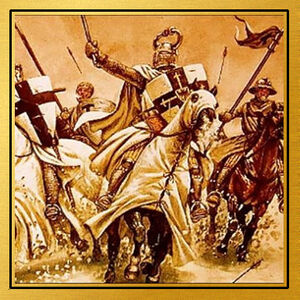| Crusading Age | |
| Period | High Middle Ages |
| Dates | 1095-1204 AD |
| Chronology | |
| Preceded by Era of the Normans |
Followed by Rise of State Power |
| “ | Christians are right, pagans are wrong | ” |
–The Song of Roland | ||
The Crusading Age lasted from about 1095 AD until 1204 AD. It began with the First Crusade, which set the precedent for the heady blend of religious idealism and astonishing barbarity. It then ended with the bizarre Fourth Crusade, where an armed expedition launched by the papacy sacked the largest and oldest explicitly Christian city in the world.
In 1094, the Byzantine Emperor wrote a fateful letter to Pope Urban II, asking for military assistance against the encoraching Muslim Turks in Anatolia (modern-day Turkey). The help he sought was merely some Western mercenaries; what he got was the First Crusaders. The ideology of Crusading was already much in the air because of developments in Spain, where the Reconquista had recently recovered the prestigious city of Toledo. Pope Urban II first issued his call at a council of French bishops and nobles at Clermont in 1095, In an emotive appeal at the Council of Clermont, Pope Urban II called for Western nobles and knights, rather than pursuing strife among themselves, to take the cross against the enemies of Christianity, with the ultimate goal of conquering Jerusalem. Soon it seemed that entire nations were on the move as Crusading fever swept Europe, sparking violence even before their departure against local Jewish communities. The fervour and moral exaltation of the movement was undeniably a genuine manifestation of Christianity. But that was only one side of the coin. Crusading warfare provided a licence for the predatory appetites of the feudal elites; they could plunder booty and land from the infidel with a clear consience. Against the odds, the fractious and naive First Crusade (1095–99) was miraculously successful. Within three years the Latin Christians had recovered Jerusalem, where they celebrated the triumph of the Gospel of Peace with an appalling massacre of its inhabitants, even by the low standards of the day. In the East they briefly established new Crusader States; the kingdom of Jerusalem, and its nominal vassals of Antioch, Tripoli, and Edessa.
The nature of Crusading proved unsuited to the defence of the Holy Land. Religious fervour was difficult to direct and control, while European knights usually returned home once their personal pilgrimage was complete; it was standing armies that the Latin Christian states needed, not short-lived expeditions. Moreover, the success of the First Crusade owed much to a passing phase of weakness and anarchy in the Islamic world. Zengi, a Seljuk general, saw the possibilities of exploiting Christian mistreatment of the local Muslim population to build-up a powerful sultanate in Syria. In 1144, he recovered Edessa, shocking the West and the Pope into calling for the Second Crusade, though it accomplished almost nothing. Zengi's son, Nur al-Din, went on to extend power in Egypt too, establishing a single Muslim state completely surrounding the Latin kingdom. It was a usurper of this sultanate, Saladin, who proved the West's greatest nemesis of the Crusading Age. He remains a captivating figure even after strenuous efforts by sceptical historians to cut-through the romantic image of the "chivalrous Saracen"; a man of his word and just in his dealings. Saladin’s first great triumph was the recapture of Jerusalem in 1187, which provoked a new Third Crusade. Richard the Lionhead was a worthy opponent to Saladin, twice marching to within sight of Jerusalem, but eventually realised that, even if he could recover it, he could never defend a city so far from naval support.
The first three Crusades had brought greater contact between the Latin West and Orthodox East, but familiarity, however, did not lead to a greater understanding. It may have been too obvious that many Byzantines thought of the Latins as greedy barbarians. It was certainly too obvious that Constantinople had little sympathy with the Crusader States, which always enjoyed a warm glow of religious frontline commitment in the minds of Western observers. The tone of awe at the great city's grandeur steadily transitioned to a view of the Greeks as duplicitous, decadent, over-clever, and ungrateful cowards; even their religious practices were suspect, for the Great Schism had been in effect now for a century-and-a-half. The idea of conquering the largest, wealthiest, and most sophisticated Christian city in the world was unthinkable to most Europeans, but that is what happened. Though a bizarre combination of cock-ups, financial constraints, Venetian cynicism, and Byzantine in-fighting, Constantinople was brutally sacked in 1204 by the Fourth Crusade, and a new Crusader State set-up in its stead. The Byzantine government nevertheless survived in exile and recovered Constantinople in 1261, but the damage was done; the heart had gone out of Byzantium, though it had still two centuries in which to die. This event far from discredited the Crusading ideal which continued throughout the 13th-century, though with little success. Under the ruthless Baybars and his successors, the Muslims finally swept the Latin Christian states from the Holy Lands in 1291.
The Crusading Age had profound consequences for all those involved. It created an enduring sense of unbridgeable ideological separation between Christianity and Islam. Among other things ending the possibility of the two religions living side by side, as they had oftern done in Spain and Sicily. The division of Christendom was embittered too. The sack of Constantinople left a deep sense of betrayal, so quickly forgotten by the West, that endured in the memory of their Orthodox co-religionists; the Great Schism endures today. The other side of this coin is that, for two centuries, the Crusades bound Western Europe together in a great moral and spiritual enterprise. It fed their own sense of identity, that the people of Europe did share a common civilisation and cultural heritage. A material effect was that trade between East and West increased phenomenally during this period. This may have occurred anyway, for Western Europe’s population, wealth, and demand for sophisticated Eastern products was growing, but the Crusades hastened the developments. The Crusades have cast a very long shadow indeed, in a new temper in Latin Christianity, a militant tone and an aggressiveness which would often break out in centuries to come. In it lay the roots of a mentality which, when secularized, would power the world-conquering culture of the modern era. Modern Islamic nationalism has drawn parallels between the Crusades and political developments such the establishment of Israel in 1948, as well as encouraging ideas of a modern jihad against Western states
History[]
Byzantine Faltering[]
Under Emperor Basil II (d. 1025), the Byzantine Empire reached the zenith of its medieval power and dignity. The conquest of Bulgaria and the Slavic Balkans created a more stable and secure border, safe from Magyar (Hungarian) and Turkic Khazar raiders. The Balkans, Greece, Anatolia (modern-day Turkey), northern Syria, and the south Italian mainland were under stable Byzantine control, all governed by a single and cohesive political system with a complex fiscal structure that the West would not match for centuries. Constantinople itself, at probably half a million inhabitants, was the largest city that ever existed in medieval Europe, renowned as far away as Scandinavia, where it was known simply as, "the City". The Macedonian Renaissance was taking effect, seeing the assimilation of classical hellenic styles into Christian art, and the University of Constantinople as the main source of Christian learning for its day. Basil had even managed to leave a burgeoning treasury, despite fighting military campaigns so regularly. Yet, it took his successors just 46-years to squander his legacy and engineer such a disastrous defeat at Manzikert that the empire never recovered.
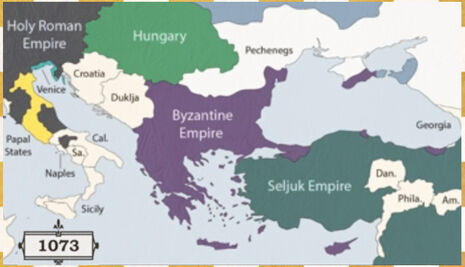
Basil II never married and left no heir, so was succeeded by his worthless brother, Constantine VIII (d. 1028) and his family. Over the next 56 years, there were no less than thirteen emperors, none with any particular political or military talent. They allowed the state increasingly fell into the hands of a poisonous court, dominated by two self-interested factions; the urban aristocracy of Constantinople, and landed aristocracy of the provinces. Each faction put-up rival emperors from the royal family. The sophisticated urban aristocracy favoured men who would expand the imperial bureaucracy, thus supplying them and their families with lucrative offices and decorative titles; rapidly draining the treasury in the process. The provincial nobility, who had been punished by Basil's legislation, wanted emperors who would give them free-rein to expand their estates and exploit the rural peasantry. Before the 11th-century, great landowners had never been locally dominant within the empire, with a substantial free-holding peasantry, as well as the tenant peasant-militia of the theme estates, who formed both the backbone of the army, and a major source of tax receipts. Now peasants found themselves increasingly falling under a form of feudal serfdom. The unfortunate consequence of all this was the army and navy were starved of funds and manpower, at the very moment that new enemies were appearing on almost every frontier almost simultaneously. To the north, the Byzantines had long maintained relatively good relations with Kievan Rus' and the Khazars, but in the late-10th-century both were pushed aside by more aggressive peoples, steppe nomads such as the Pechenegs and Cumans, whose raids into Thrace and Macedonia became a constant menace. Meanwhile, Western Europe too was revealing itself to be a predator, beginning with the Norman conquest of Byzantine southern Italy and religious strife between Constantinople and Rome that culminated in the Great Schism of 1054; that the Byzantine Empire had for centuries absorbed much of the Islamic onslaught which might otherwise have fallen on the West, would not save her. The last capable Byzantine general in southern Italy, George Maniakes, fell victim to court intrigue in 1043, and the Normans made steady progress after that. But the greatest danger was the eastern frontier, where the arrival of the Seljuq Turks was to change the whole shape of the Muslim and Byzantine worlds.
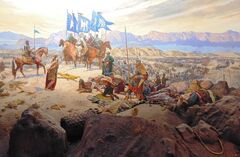
The Battle of Manzikert, a turning point in the story of the Byzantine Empire. The victorious Seljuk Turks captured the Byzantine Emperor, and, with the empire in disarray as generals squabbled for the throne, nothing could stop them sweeping across Anatolia.
Having conquered Persia and wrested political authority from the Abbāsid Caliphs of Baghdad by 1055, the Seljuks made their first incursions across the Byzantine frontier into Armenia in the late 1050s, where they found an empire whose once-formidable military had been allowed to decay to the point of incompetence. They began by systematically reducing the Byzantine defensive system, a chain of fortresses stretching from the Caucasus to Syria. The first to fall, Ani in 1064, became their base-of-operations for the rest of the campaign, which three years later had reached as far west as Caesarea in central Anatolia. The emergency lent weight to the provincial noble faction, who secured the election of one of their own as emperor, Romanus IV Diogenes (1068-1071). Romanus was at least a capable general, who assembled a 40,000 strong army and took it east in a series of campaigns that culminated in the disastrous Battle of Manzikert (August 1071). It was a sign of the times that his army was mainly composed of conscripts and foreign mercenaries. At Manzikert, Romanus slightly outnumbered his enemy, and might have won, if his position had not been undermined by the unreliability of mercenaries and treachery within his own ranks. He made the foolish mistake of trusting his reserves to a political rival, Andronikos Doukas, a prominent member of the urban noble faction, which had held the throne until Romanus' elecation. When the right flank of the Byzantine line began to falter, Doukas failed to support it, throwing the entire army out of cohesion. Romanus, who was leading the center, had to watch as the mercenaries on the left flanks fled the field, leaving dangerously exposed. He made a defiant stand alongside his Varangian Guard, fighting valiantly even after his horse was cut from under him, but in the end was encircled and captured. Byzantine scholars would later look back and lament Manzikert as the moment the empire's precipitous decline began. But the defeat didn't have to be the long-term catastrophe that it became. Compared to other famous Roman disasters such as Cannae or Adrianople or Yarmouk, the casualties at Manzikert were quite modest at 5,000; barely an eighth of the army. Moreover, the Seljuks were distracted by war with Fatimid Egypt, and released Romanus just a week later, in return for a not ungenerous peace treaty. A capable emperor could have salvaged the situation. Instead, chaos reigned as Byzantium's resources were squandered in a decade-long series of civil wars over the throne. Romanus himself returned to Constantinople to find the Doukas family had already usurped the throne. Despite attempts to raise loyal troops, he was defeated, deposed, cruelly blinded, and endured a painfully lingering death. The beastly or incompetent emperors who followed him, lost in their petty squabbles, refused to honour the peace treaty with the Seljuks. The Turks thus felt justified in continuing their campaign, and by 1081 had reached Nicaea. The heart of the empire’s military and economic strength in Anatolia, which the Arabs had never mastered, was now under Seljuk rule.
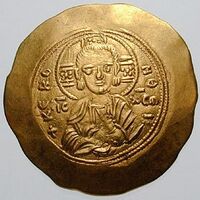
Alexios I Komnenos, among the last of the great Byzantine Emperors. He inherited an empire riven by factionalism and surrounded by enemies, but overcame a series of crises to inaugurate a century of modest recovery.
The final straw for Byzantium was the disastrous reign of Emperor Nikephoros III Botaneiates (1078-81). The new emperor was at least a general, but, at 78-years-old, he had used what energy he had left on a successful bid for the throne. Once there, he rapidly sank into debauchery and senility. As a usurper, the most pressing problem as Nikephoros saw it was shoring up his legitimacy. He thus married Maria, the beautiful 29-year-old widow of the emperor he had just ousted. He then made matters worse by reneging on a promise to name Maria's son as heir. The boy's father-in-law was not amused, the brilliant Norman adventurer, Robert "Guiscard" de Hauteville (d. 1085). Guiscard, on the lookout for just such a pretext, immediately sailed from southern Italy, and invaded Byzantine Greece. In this new crisis, Alexios I Komnenos (1081-1118), the ablest general of his day, seized the Byzantine throne in an almost bloodless coup; accepting his fate, Nikephoros abdicated and retired to a monastery. Many who watched Alexios' coronation must have done so without much enthusiasm, seeing just another in a long line of usurpers. Indeed, the empire seemed almost beyond saving. Although his 35-year reign was full of struggles, Alexios would prove one of the last great Byzantine emperors. The history of his reign was written in elegant Greek by his daughter Anna Komnene; and, as she remarks, it began with an empire beset by enemies on all sides. Robert Guiscard, and his equally formidable son Bohemond (d. 1111), were besieging Dyrrhachium (modern-day Durrës in Albania), the main Byzantine fortress on the Adriatic coast. Alexios decided to confront his enemies head-on, but the resulting Battle of Dyrrhachium (October 1081) exposed all the flaws of the ill-disciplined mercenary-based Byzantine army; Alexios himself barely escaped the rout. Dyrrhachium soon fell, but if Guiscard thought that Alexios was beaten, then he was soon to learn that there was more to war than fighting. Alexios immediately began plying the diplomatic waters, seeking allies. The German king-emperor, Henry IV, proved immediately receptive, in the midst of his quarrel with Pope Gregory VII, a Norman ally. Then to make doubly sure, Alexios made an alliance with the Republic of Venice to harass the Norman navel supply-lines, bought at the cost of extensive trading privileges within the Byzantine Empire that would have unforeseen long-term consequences. Guiscard was forced to return to Italy to support the Pope for four years, leaving Bohemond to continue the campaign alone. Over the next few years, Alexios harassed the Normans, while simultaneously offering them bribes to defect. With Guiscard's death in 1085, the Normans departed allowing the Byzantines to recover all their lost territory. Alexios had learned a valuable lesson from the Normans; his army needed time to be rebuilt, and until then success depended on diplomacy and intrigue. Fortunately for the empire, as he would prove again and again, in the 11th-century there was no better. In 1090, the Turkic Pechenegs crossed the Danube to raid Byzantine Trace once again. Alexios overcame this crisis by allying with a rival nomadic group, the Cumans, and together they crushed the Pechenegs at the Battle of Levounion (April 1091). When the Cumans then became over-ambitious, Alexios found a disgruntled group of Cumans, and bribed them to assassinate their chieftain. The message to Byzantium's enemies was clear; invade the empire at your peril, and leave no rivals in your wake for Alexios to exploit. After thirteen years on the throne, Alexios could finally turn his attention to Anatolia, where the situation had changed dramatically. Upon the death of the third Seljuq Suntan, Malikshāh I (d. 1092), the empire fell into chaos, as rival successors and regional governors carved up the state, and waged war against one another. This seemed just the opportunity that Alexios had been looking for to reclaim the empire's lost territory. But he still lacked the troops to go on the offensive. Always looking for possible allies, Alexios had worked dillegently to repair relations with the Papacy. In 1095, he wrote a fateful letter to Pope Urban II asking for Western support. The help he sought was simply some mercenary forces; what he got was the First Crusaders.
First Crusade[]

Pope Urban II at the Council of Clermont from the Livre des Passages d'Outre-mer, c 1474. The council witnessed the pope's historic call for the First Crusade to capture Jerusalem for Christendom from its Muslim "occupiers".
When Emperor Alexios appealed to the Papacy for help, he perhaps failed to appreciate the complicated political situation in Latin Christendom at the time. By the late-11th-century, Western Europe's population, prosperity, and self-confidence were growing. It now possessed the capability to plan and carry through major military expeditions, as evident from the Norman conquest of England in 1066. At the same time, royal authority was weak in many parts of the continent, plagued by ambitious and prickly feudal lords with little to do but fight among themselves. The Christian Church attempted to moderate their endemic warring. One of the best-known examples was the Peace of God movement in central-southern France from 968, which sought to restrict the depredations of local lords to certain days of the week and times of year. Another solution was for Europe's knights to turn their efforts outward towards enemies of Christianity. As early as 1063, Pope Alexander II (1061-73) sponsored an armed pilgrimage to support the Reconquista against Muslim Spain. At the same time, the reform-minded Papacy was embroiled in a protracted series of quarrels with secular rulers, to assert the independence of the Church. The power struggle between Church and State had begun in imperial Germany with the Investiture Controversy on 1076, and would continue in England and France into the 13th-century. For Pope Urban II (1088-99), Alexios' appeal for help was the perfect opportunity to enhance the prestige and secular power of the papacy, by placing a large number of fighting men under direct Church control. Urban may have even hoped that, by helping Byzantium in her time of need, he could heal the rift of the Great Schism of 1054, and perhaps even bring the Eastern Orthodox Church under papal primacy. On the first days of November 1095, at the Council of Clermont in southern France, Urban delivered what was probably the most effective speech of the entire Middle Ages. It is difficult to know what was actually said, because all the surviving accounts were written decades later and differ widely from one another. There seems to have been little mention of Emperor Alexios, and the goal was much bolder than recovering lost Byzantine territory; he instead summoned a righteous war against the Muslims, with the ultimate goal of recovering the Jerusalem for Christianity. The Pope's message was spiced-up with tales of how the Muslims brutally oppressed their fellow Christians in the East, and prevented Western pilgrims from reaching the sites of the Holy Land. Some historians would call this a pretext, rather than a justification. The Islamic world had always shown a remarkable tolerance to other religions, especially Christians and Jews as fellow "people of the book". Arabic sources mark clear that Christians often held high offices, and it was not uncommon for Muslim rulers to have Christian-born wives or mothers. Apart from paying a special Jizya tax, Christians were able to play a full role in the community, certainly more that Muslims or Jews could in Latin Christendom. And Western pilgrims were actively encouraged to visit the Holy Lands, since it benefited the local economy. It is true that fighting between the Sunni Seljuks and Shi'a Fatimids in the region had made the pilgrimage trails more difficult and dangerous in recent years.

Peter the Hermit and his People's Crusade. Despite the pope’s deliberate intentions to appeal specifically to knights, a number of unexpected bands of peasants and low-ranking knights set-off for Jerusalem on their own, spurred-on by the charismatic preacher.
It is clear that the response to his speech at Clermont was much greater than even the Pope Urban II had expected. According to one account, the enthusiastic crowd responded with cries of Deus vult! ("God wills it!"), and several prominent lords pledging themselves to the First Crusade on the spot. Soon it seemed that entire nations were on the move as Crusading fever swept Europe. At a local level, the religious fervour sparked violence against non-Christians even before leaving Europe. At the end of 1095 and beginning of 1096, there were attacked on Jewish communities in Germany and France, with notable massacres first at Speyer, and then with increasing ferocity in Worms, Mainz, Cologne, Trier, Metz, and Prague; forced to convert or die, many Jews chose death. This is often cited as a pivotal turning point in Jewish and Christian relations in the Middle Ages; anti-Semitic persecution increasingly became a feature of European life from the 12th-century. Throughout 1096, nobles and knights predominantly drawn from the French aristocracy "took the cross". The fervour and moral exaltation of the crusading movement was undoubtedly a genuine manifestation of Christianity. Men joined for the defence of the faith therefore pleasing to God, as well as for personal salvation with remission of sins offered to any who might die in the undertaking; in time, this idea would evolve into the system of Indulgences (buying a remission of time in Purgatory) that would so incense Martin Luthar in 1517. But that was only one side of the coin. It also provided a licence for the predatory appetites of the feudal military elites. Crusading warfare would offer loot and licence on a scale unavailable in Christendom’s domestic wars. They could spoil the pagans with clear consciences. "Christians are right, pagans are wrong", said the Song of Roland, and that probably sums up the average Crusader’s response to any qualms about what he was doing. The vast majority of warriors had far less glamorous motives, simply compelled to follow their feudal lords. In the end, more men would pauper themselves to fight for their faith, than got rich; travelling to the Holy Lands was afterall very expensive. Incidentally, the Church would dramitically increased its landholdings in this period by buying up feudal estates. Pope Urban sought an organised army of knights, under his papal legate Bishop Adhemar of Puy (d. 1098). He tried to forbid certain people (including women, monks, and the poor) from joining the Crusade, and made no effort to lift excommunications on several European kings and great nobles, who might hijack the movement. The flower of European chivalry, however, were not the first to undertake the arduous journey towards the Holy Land. Contrary to the Pope's wishes, several ill-disciplined bands of peasants and petty knights set off for Jerusalem, months before the planned departure in August 1096; commonly known as the People's Crusade (April-October 1096). The most famous of these was brought together by a remarkable popular preacher called Peter the Hermit (d. 1115). Peter's fledgling "army" arrived in Constantinople unharmed in August 1096, despite making few friends while crossing Hungary and Bulgaria by pillaging the countryside and robbing markets for food. An appalled Emperor Alexios urged the unruly mob to wait for the main body of Crusaders, but then hurriedly ferried all 30,000 across the Hellespont. In Anatolia (modern-day Turkey), what little discipline there had been quickly broke-down, as the Crusaders spurred each other on to move more boldly against the infidels. When they reached the edge of Seljuk held Nicaea, they immediately fell into an ambushed and were virtually wiped-out. About 3,000 found refuge in an abandoned castle and were eventually rescued by the Byzantines. Thus ended the sad and sorry tale of the People's Crusade, but this was not the end for Peter the Hermit himself; he survived and joined the official Crusader, but aside from a few rousing speeches played no significant role.
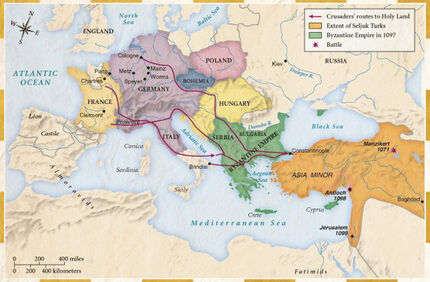
The main force of the First Crusade (1095–99) departed in August 1096 as Pope Urban directed. It consisted of four main armies that made their way to Constantinople separately from different regions of Europe; from Germany, northern France, southern France, and Norman Sicily. There was a huge cast of nobles among the leadership of the Crusade, including brothers of the kings of France and England, but the six men who would most shape the course were: Bishop Adhemar of Le Puy (d. 1098), the papal legate and spiritual leader; Raymond of Toulouse (d. 1105), one of the most powerful and wealthy nobles of France, who perhaps expected to be the leader alongside Adhemar; Bohemond of Taranto (d. 1111), a Norman from southern Italy who had fought the Byzantines several times with his father Robert Guiscard; Tancred de Hauteville (d. 1112), a nephew of Bohemond; Godfrey of Bouillon (d. 1100), the only major German noble, who had previously been an anti-papal ally of king-emperor Henry IV; and Baldwin of Boulogne (d. 1118), Godfrey's morally flexible younger brother. Except for some pillaging, the whole host met-up in Constantinople in spring 1097 without serious incident. The presence near the city-walls of a slightly hostile army, numbering perhaps 35,000 including 5,000 mounted knights, would have been daunting for any ruler, but Emperor Alexios handled the situation with shrewd diplomacy. As each contingent arrived, they were quartered outside Constantinople, allowing only small unarmed groups inside the city under escort. He met personally with each leader, and, through a careful mix of imperial splendor, costly gifts, and sabre-rattling, extracted from them oaths to restore to him any conquered territory that had belonged to the empire before the Turkish invasion. In return, Alexios promised to supply them with provisions. None took the oath willingly. Raymond of Toulouse swore only a lukewarm oath, to cause the empire no harm. Despite this, Raymond and Alexios became good friends, and Raymond remained the strongest defender of the emperor’s rights throughout the Crusade. Alexios probably had few illusions that the Crusaders keep to their promises; the oath had sprung to Bohemond's lips far too quickly to be trusted. But he had done what he could.
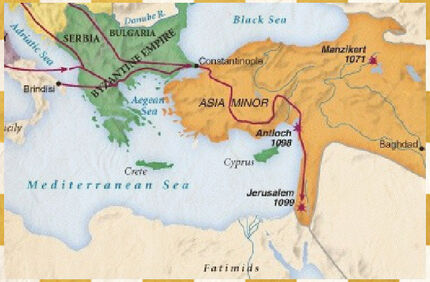
The Crusaders crossed into Anatolia in early 1097, accompanied by a Byzantine army and by Peter the Hermit. The first objective of their campaign was city of Nicaea, now the capital of the Seljuk successor state, the Sultanate of Rûm (1077–1308) under Kilij Arslan. At the time, Arslan and his army was campaigning in the east against a rival sultanate, and paid the Crusaders little heed, assuming it could be dealt with as easily as the People's Crusade. Arriving at Nicaea unmolested in mid-May, the city was subjected to a lengthy siege, with the Byzantine navy blockading resupply via Lake İznik. Arslan rushed back to Nicaea, but was driven back by the unexpectedly large crusader force. After five week, Turkish garrison, wanting to avoid a sack, secretly negotiated the surrender of the city to Emperor Alexios. There was some discontent amongst the Crusaders who were forbidden from looting the city. Alexios paid the Crusaders generously for their efforts from the Sultan's treasury, but, believing they could have had even more if they had captured Nicaea themselves, the already strained relations began to sour. At the end of June, the Crusaders left Nicaea and marched on through Anatolia toward Antioch, ignoring Alexios' advice to proceed along the southern coast route so they could be resupplied. In order to simplify the problem of supplies, the army split into two groups; one contingent led by the Normans, the other by the French. About a week after leaving Nicaea, Sultan Arslan ambushed the Normans, who had marched ahead of the French. At the Battle of Dorylaeum (July 1097), the Turks attacked in their usual style, with nimble mounted archers charging in, shooting their arrows, and quickly retreating before the Crusaders could counterattack. The Normans responded by deploying in a tight-knit defensive formation around their baggage train. Despite heavy losses, the Normans held-on for some five hours, until the French contingent arrived and launched a surprise attack on the Turkish rear, prompting Arslan to withdraw rather than face the combined Crusader army. The Crusaders marched on to Antioch, but the journey through the arid and mountainous interior was a desperate test of endurance. It took almost three months in the heat of the summer, with very little food and water, as Sultan Arslan resorted to scorched-earth tactics; most of their horses died. Even before reaching Antioch, Baldwin of Boulogne left the main Crusading army to carve-out a fiefdom for himself in the Holy Land; his wife, his only claim to European lands, had died at Dorylaeum. He eventually married the daughter of the Armenian Orthodox Christian ruler of Edessa, and probably assassinated his father-in-law to create the first of the Crusader States.
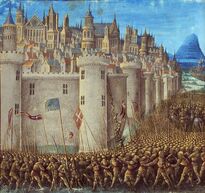
The Siege of Antioch, from a 15th-century miniature painting by Sébastien Mamerot. The Crusaders gained entry to Antioch after an eight-month siege.
It was a parched and exhausted Crusader army that finally arrived at Antioch in October 1097. One of the great cities of the eastern Mediterranean, Antioch was surrounded by an enormous circle of walls studded with more than 400 towers, built by the Byzantines after recovering the city in 969. The city was so large that the Crusaders did not have enough troops to fully surround it, so it remained partially resupplied throughout what proved a long and difficult siege. After a bitterly cold Syrian winter, the spring brought the threat of a Muslim relief army. Fortunately for the Crusaders, the Islamic world was so riven by divided that counter-offensives came sporadically, and with their own agendas. Damascus and Aleppo dispatched separate relief armies in December and February, that if they had been combined would probably have been victorious. In April, an embassy from Fatimid Egypt arrived, hoping to establish a peace with the Crusaders, who were afterall enemies of their own Seljuk enemies. As the siege went on, supplies dwindled, and one in seven Crusader was dying from starvation. With the situation seeming hopeless, people began to desert and return home, among them the French knight Stephen of Blois, the son-in-law of William the Conqueror. On his way home, Stephen met Emperor Alexios at the head of a Byzantine army marching to reinforce the siege, and convinced him that Antioch's cause was doomed. The emperor’s decision to turn back, however justified, was a diplomatic blunder. On hearing the news, Crusaders claimed that this was treachery, reason enough to break any obligation to return the city to him. Bohemond, meanwhile, proposed that the first to enter the city should have possession of it. The Norman had, in fact, already made secret contact with a discontented Armenian Christian guard called Firouz within Antioch. On the night of 3 June 1098, eight-months into the siege, Firouz allowed a small contingent of Crusaders led by Bohemond to scale the wall, and then open a nearby postern gate. The Crusaders flooded into the dozing city, and a massacre ensued, with thousands of Orthodox Christian civilians killed along with Muslims, unable to tell them apart; among them Firouz' own brother. The victory, however, was incomplete. A few days later, a third Muslim relief army from Mosul arrived at Antioch; the erstwhile besiegers were now the sieged in a city already short of supplies. Once again the situation seemed hopeless, until the Crusaders found themselves the beneficiaries of, what could be described as, if one were so inclined, a miracle. On 15 June, an otherwise insignificant priest from southern France claimed to have had visions of St. Andrew; the starving Crusaders were prone to visions and hallucinations. He began to dig in the Cathedral of Saint Peter, and produced the relic of the Holy Lance; the spear that had pierced Jesus' side as he hung on the cross during his crucifixion. Bishop Adhemar was skeptical, as he had seen the Holy Lance in Constantinople; indeed there was yet another relic claiming to be the Holy Lance in Vienna. However, most of the Crusaders took this as a divine sign that they would survive, and thus prepared for a final fight rather than surrender. On 28 June, the Crusaders sallied-out from the city-gates, carrying the Holy Lance before them. In a confused responce, the resulting battle outside the city-walls was brief and disastrous for the Turks; soon the defeated Muslims were in panicked retreat. Thus, Antioch was restored to Christian rule. As expected, Bohemond claimed the city as his own, though Adhemar and Raymond disagreed. The Crusaders remained in city for almost a year, violently disagreeing over the disposition of Antioch, and subduing the surrounding countryside for food and horses. Meanwhile plague broke out in the city taking many lives, including Bishop Adhemar, the spiritual leader of the Crusade. The bishop had been a wise counselor and a stabilising influence that the quarrelsome leadership could ill-afford to lose.
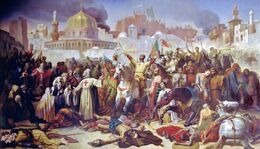
Capture of Jerusalem by the Crusaders, by Émile Signol 1847. The siege is notable for the mass slaughter of Muslims and Jews perpetrated by the Christian Crusaders, the single greatest atrocity of the entire period.
In January 1099, the minor knights became restless and threatened to continue to Jerusalem without their leaders. Raymond finally gave-in and the march restarted, leaving Bohemond behind as the first prince of the Crusader State of Antioch; he thus ignored both his oath to Alexios and his Crusading oath. Proceeding down the Mediterranean coast, the Crusaders entered Fatamid territory rather than Seljuk, and met little resistance, with their reputation for barbarity preceding them. Finally in June, the Crusaders reached Jerusalem, three long years after they had set out; many wept upon seeing the city. The governor was well-supplied and confident that he could withstand a siege until a relief force arrived from Egypt. The Crusaders, on the other hand, were reduced to less than 14,000 men. There was no hope of trying to besiege the city as they had at Antioch; the Crusaders resolved to take it by assault. On 8 July a strict fast was ordered, and, with the Muslims scoffing from the walls, the entire army marched in solemn procession around the city, and thence to the Mount of Olives, where Peter the Hermit preached with his former eloquence; apparently as instructed in a vision of Bishop Adhemar. The full assault on Jerusalem began on 13 July, with Raymond of Toulouse leading the attack on the southern part of the wall, and Godfrey of Bouillon positioning his forces on the north. After a day of little headway, Godfrey dismantled his siege towers during the night, and move them to a different part of the wall. The assault recommenced, and raged throughout the next day, into night, until Godfrey’s men finally took a sector of the walls and opened the nearest gate. On 15 July, the Crusaders flooded into the great city, and an most un-Christian slaughter ensued that has attained particular notoriety, as a "juxtaposition of extreme violence and anguished faith". Atrocities committed against civilians were normal in medieval warfare; the Christians had already done so at Antioch, as the Fatimids had done so themselves at Tyre in 996. However, the massacre of Jerusalem exceeded even these standards. The majority of the inhabitants were slaughtered, Muslims, Jews, men, women, and children; all the Orthodox Christians had been expelled before the siege. The only Muslims to escape were the city governor and his bodyguard, having surrendered the citadel in return for safe passage. The barbarism shocked even Christians, with Tancred de Hauteville giving his personal banner to a group of civilians, which should had assured their safety; they were killed anyway by other Crusaders. The eyewitness accounts of the Crusaders themselves leave little doubt that there was great slaughter, with one describing it as the "just and wonderful Judgement of God". It continued for at least two-day, which some historians see as suggesting deliberate policy rather than simple bloodlust; to remove the contamination of "paganism". How many people were killed is a matter of debate, but the city's population probably around 40,000. Capturing Jerusalem was a remarkable achievement, but holding onto it was going to take more fighting. Within a month, a large Egyptian army arrived to take back the city. However, the Crusaders marched out, and launched a surprise dawn attack, routing the over-confident and unprepared Muslims at the Battle of Ascalon (August 1099). Over several years, they were also able to secure control of the coastline with the aid of the Venetians and Genoese, who, as was customary, received extensive trading privileges; the port-cities of Acre, Beirut, Sidon, and Tyre was in Latin hands by 1124. From a modern perspective, the improbable success of the First Crusade is staggering. For medieval men and women, though, it was the work of God himself, who worked miracle after miracle for his faithful knights. It was this firm belief that would sustain centuries of Crusading.
Crusader States[]
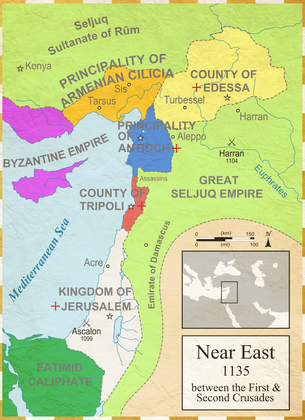
With the recovery of Jerusalem, attention soon turned to a problem of at least equal concern to many Crusaders; governing the newly conquered territories. The administration of the Crusader States (1098-1291) evolved over the next decade, settling into four feudal states. The most important was the Kingdom of Jerusalem (1099-1187), extending from Beirut in the north almost to the Sinai Desert in the south. The Crusaders thwarted plans for the Holy City to be ruled under ecclesiastical authority, and Godfrey of Bouillon become its first king, over the claims of Raymond of Toulouse. The other three Crusader States were at least in theory vassals of Jerusalem: the Principality of Antioch (1098-1268), the County of Edessa (1098-1144), and finally the County of Tripoli (1109-1289), which was captured by Raymond's son after being outmaneuvered in Jerusalem. The European imposed their feudal system of governance on the region, with fiefdoms distributed to nobles and their followers in due degree. Castles were built at strategic or vulnerable points, among the most famous being Krak de Montréal and Krak des Chevaliers, tangible symbols of the dominance of a Latin Christian minority over a somewhat hostile majority population. The peoples of the Crusaders States were certainly cosmopolitan, with Latin, Orthodox, and Monophysite Christians, Sunni and Sh;ia Muslims, and Jews. Yet cross-cultural exchange, so fruitful in Spain and Norman Sicily, was decidedly lacking, with the Franks, as the locals called the Latin settlers, lording over the native population who lived like Western serfs. Only in medicine was there any willingness to learn from the infidel, as testified by the Crusaders who relied on Arab doctors on numerous occasions. The Crusader States survived far longer than might have been expected. Although surrounded by Muslim territory, they long benefitted from the chronic political and religious disunity amongst the rival rulers in Cairo, Damascus, Aleppo, Mosul, Konya, Diyarbakır, and Baghdad. Indeed, contemporary Arab chroniclers did not recognise the Crusaders as religiously motivated, assuming this was the latest phase in ebb and flow struggle with Byzantium. The Latin states presented an obstacle to Muslim trade with the Mediterranean and the land routes to the urban economy of Egypt. Yet this commerce not only continued but expanded, with spices, carpets, silk, dyes, sugar, and other eastern wares exported to Europe in unprecedented volumes. This may have occurred anyway, for Europe was growing wealthier, but the Crusades hastened the developments. The revenues of the Latin states were largely based on market tolls, while the Italian Maritime Republics of Venice, Pisa and Genoa grew rich through monopolising shipping and developed into Mediterranean powers. The Crusader States remained militarily weak and politically unstable throughout most of their existence. The nature of Crusades was unsuited to the defence of the Holy Land. Crusaders were on a personal pilgrimage and usually returned when it was completed, but the Crusader States needed large standing armies. Religious fervour was difficult to direct and control even though it enabled significant feats of military endeavour.
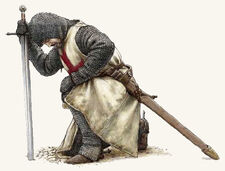
The Knights Templar, a religious military order of knighthood, founded in 1119 and active until about 1312. Their knights wore the famous white surcoat with a red cross, and a white mantle also with a red cross.
One of the main aims of the Crusade had been to enable pilgrims to reach the holy sites of Palestine. Protecting them from illness and attack was seen as an important task, which prompted the founding of several military-religious orders of knighthood, the most famous being the Knights Templar, Knights Hospitaller, and the later Teutonic Knights. The Knights Templar (1119-1312), or Poor Knights of Christ and of the Temple of Solomon, were the earliest and most influential of the military orders. It was formed in 1119, when about nine French knights created a brotherhood who took monastic vows of piety, poverty, chastity, and obedience. They were granted a headquarters on the Temple Mount, below the ruins of the Temple of Solomon. The order was organized on a military basis, and relied on donations to survive. Their impoverished status did not last long. The Templars became a favoured charity throughout Christendom and grew rapidly in membership and power. Templar knights, in their distinctive white mantles with a red cross, made up as little as 10% of their members. Non-combatants managed feudal estates from Denmark to Spain, from Ireland to Armenia, as well as developing an early form of banking. With a reputation for honesty, Templar convents became a safe repository for cash, valuables, and important documents; people could make regular deposits like an modern bank account. They could even deposit money at one convent and, on showing a suitable letter, then withdraw equivalent money from a different convent; especially useful for the dangerous journey to the Holy Lands. At the peak of their power, the Templars had a network of nearly 1,000 convents and fortifications across Europe and the Holy Land, arguably forming the world's first multinational corporation. The Knights Hospitaller (1023-1798), or Knights of the Hospital of St, John, actually pre-dates the Templars as a religious order. In 1023, merchants from Amalfi in Italy were given permission by the Fatimid Caliph to build a hospial in Jerusalem to care for sick pilgrims. With the arrival of the Crusaders in 1099, the Hospital of St, John grew in importance and in wealth. Crusader knights, grateful to have their wounds healed, granted them land and revenues throughout the Holy Lands and beyond. The order never abandoned its original purpose, and, influenced by the Templars, they became a religious order that knights could join too. Like the Templars, the Hospitallers were some of the best-equipped, well-trained, and highly-disciplined soldiers in the Holy Land, and become an integral part of its defence, with castles of their own. Krak des Chevaliers acquired and extensively rebuilt by the Hospitallers in 1144, was the largest Crusader castle in the Holy Lands, and considered virtually impregnable. When the Holy Land was lost in 1291, support for both orders faded. Without the charitable function which nourishes the Hospitallers, the Templars were exposed to the temptations and jealousies of political life. Kings were also understandably wary of a serious challenge to royal authority from these elite knights who were a law unto themselves, answerable only to the pope. In 1312, Philip IV of France, with the pope in his pocked and an avaricious eye on their wealth, abruptly destroyed the Knights Templars, unjustly accused of heresy. The Knights Hospitaller faired better, capturing the island of Rhodes from the Byzantines in 1310, and ruling it until 1522, when they were driven-out by the Ottomans. The Hospitallers relocated to Malta as a Spanish vassal state, but the religious fervour of the Crusades had long since passed, and the order dwindled; still it soldiered on until Malta was captured by Napoleon in 1798. The Teutonic Knights (1191-1525) were formed much later and quite different from the Templars and Hospitaller. The main German contingent of the Third Crusade failed to reach the Holy Lands due to the untimely death of Frederick Barbarossa, but some German knights pressed on and assisted in the siege of Acre. A group of them form a fraternity similar to that of the Knights Hospitallers, with a hospital in Acre and a handful of castles around it. Their headquarters remained Acre until the city’s fall in 1291, but as early as 1211, German Teutonic Knights were diverting their energies to a different sort of Crusade; the Wendish Crusades against the pagan Slavs to the east of imperial Germany and the Baltic area. They eventually carved-out a vast feudal state for themselves, the State of the Teutonic Order (1226-1525), and played an important role in the emergence of Prussia.
Second Crusade[]
The Muslim reaction to the First Crusade began with the rise of Imad ad-Din Zengi (1127-46), the Sultan of Mosul. Despite his reputation as the first great champion of the Jihad ("holy war") against the Crusader States, he fought with equal enthusiasm against his Muslim neighbours. Not happy with only ruling Mosul, the ambitious Zengi immediately began to extend his power westwards, taking Muslim Aleppo in 1128. Two years later, Zengi allied with Muslim Damascus against the Crusaders, but this was a ruse; he had the sultan's son taken prisoner and extorted Hama from him, uniting three cities into a formidable sultanate. This new threat forced the Crusaders to form alliances with Muslim powers against their common enemy; when Zengi moved against Damascus itself in 1139, he was repelled with the help from Christian Jerusalem. From Aleppo, Zangi was well-placed to threaten the most exposed of the Crusader States, Edessa, which jutted-out into the Syrian desert. But this was not part of his plan until, in 1144, Edessa allied with the Muslim Diyarbakır, and marched almost their entire army on Aleppo. With the city defended, as a contemporary chronicler put it, "by shoemakers, weavers, silk-merchants, tailors, and priests", he hurried north to besiege the city, which fell in December 1144 after a four-week siege. Attempts at recovery failed, and the northernmost Latin state was lost.
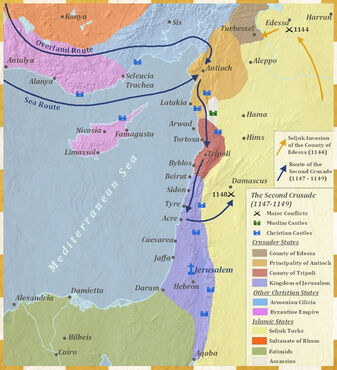
It had long been apparent that Edessa was vulnerable, but its loss stunned Western Christendom. In 1145, Pope Eugenius III (d. 1153) issue a papal bull calling for the Second Crusade (1147-50). This was the first bull of its kind, which precisely worded the promised remission of sins for all those who took the cross, as well as ecclesiastical protection for their families and property. The Second Crusade, departing in summer 1147, had much more prestigious leadership than the First; two of Europe’s greatest kings. One army was taken east by Louis VII of France (1138-80), and another by Conrad III of imperial Germany (1138-52). Despite the royal seal of approval, the expedition was on all fronts a disaster. If the kings found it difficult to control their nobles at home, on campaign it proved next to impossible. When the German contingent reached Constantinople in September 1147, Emperor Manuel I Komnenos (1143-80) was not best pleased. The Crusade wreaked havoc with his foreign policy, which included an alliance with Germany, Venice, and the pope against the Norman Sicily, which had recently seized Byzantine Corfu. It was also complicated by a truce with the Sultanate of Rūm to secure Byzantine Anatolia. Although the Crusader States recognised the need for diplomacy with Muslim neighbours, Latin Christians from the West saw the Manuel’s move as confirming the duplicity of the Greeks. Nevertheless, the emperor adroitly managed the situation and ferried the Crusaders across the Hellespont without incident. Rejecting Manuel advise to follow the southern coast, in Byzantine rather the Muslim territory, Conrad marched across the arid and mountainous interior of Anatolia, having promised his men that they would be following in the footsteps of the First Crusade. Near Dorylaeum, not far from where the First Crusaders won their first victory, the weary army was set upon by the Turks and virtually destroyed; Conrad and a few survivors retreated to Nicaea, and eventually eventually reach Jerusalem by ship. Louis and his French contingent crossed the Hellespont in November, about a month after the Germans. He took the southern coast route, but it proved extremely harrowing. A small contingent of the German army had followed this route, pillaging all the way, and many of the Byzantine cities were unwilling to trade with the Crusaders. With supplies running short, and continually harassed from afar by the Turks, the French reached the port of Adalia, where Louis and his close associate decided to sail for Antioch. The rest of the army had to resume the long march, and were almost entirely destroyed, either by the Turks or by sickness. From Antioch, the Crusaders made their way to Jerusalem without major incident. Despite the losses already suffered by the Crusaders, it was possible to field an army of nearly 50,000 men, the largest Crusade army so far assembled. In June 1148, at a council to discuss how best to proceed, it was decided to attack Damascus. How this decision was reached has long perplexed historians; Damascus, fearful of the expanding power of Zengi, was the one Muslim city disposed to cooperating with the Franks. It well-illustrates the gradual divergence of interests between Crusaders who settled in the East, and Crusader armies from the West. The Crusaders States sought to secure their survival, and, if sound strategically, would make alliances with the Muslims; they had more in common with Byzantium in many ways. The Western Crusader armies were ideologically driven, seeking glory and plunder through spoiling the infidel, irrespective of the consequences; Damascus was simply a prestigious and wealthy prize. The Damascans now had little choice but to the call on their former enemy for aid, Zengi's son, Nur ad-Din Zengī (1146-74); Zengi himself had been assassinated by a slave a few months earlier. Not only was the Crusader campaign poorly conceived, but it was badly executed. After a four-day siege, with Nūr al-Dīn’s forces nearing the city, it became evident that the Crusader army was dangerously exposed, and a retreat was ordered. A new plan was made to besiege Muslim Ascalon (the gateway to Egypt), but Conrad and Louis had quarrelled at Damascus, and it came to nothing. With that, the Second Crusade fizzled-out, having accomplished almost nothing. It's only tangible success was helping the Portuguese capture of Lisbon from Muslim Spain, achieved by a group of English Crusaders whose ship stopped there en-route.
The loss of face for the French and German kings was considerable, but the damage done to the Crusaders' cause was greater still. The leaders inevitably looked for a scapegoat, with the blame unjustly heaped on Byzantium. Indeed, King Louis' resentment was so great that he openly accused the Emperor Manuel of colluding with Turks in Anatolia, and even agreed a plan with Roger II of Sicily for a new Crusade against Constantinople. Lacking papal support, the plan came to nothing, but the perception that the Byzantines were part of the problem rather than the solution became widespread in Europe. In the Holy Land, the Second Crusade had disastrous long-term consequences. The Muslims were enormously encouraged, having confronted a major Western expedition and triumphed. And the people of Damascus had now lost patience with the Christian kingdoms. When Nur ed-Din appeared below the city-walls in 1154, the population open the gates to his army. Thus, Damascus was annexed to Zengid territory, one more stage in the encirclement of the precarious Crusader States by a single Muslim power. All that was needed now was a unifying force, and this was provided by the West's greatest nemesis of the Crusading Age, Saladin.
Rise of Saladin[]
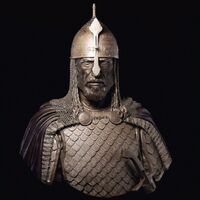
Sculpture of Saladin in the Egyptian Military museum in Cairo. Saladin’s skills in warfare and statecraft, as well as his personal qualities of generosity and chivalry, has resulted in him being eulogised by both Christian and Muslim writers.
Salah ad-Din Yusuf ibn Ayyub (d. 1193), known in the West as Saladin, remains a captivating figure even after strenuous efforts by skeptical historians to cut through the romantic image of the "chivalrous Saracen"; a man of his word and just in his dealings. Saladin's rise began under the tutelage of his uncle Shīrkūh (d. 1169), a prominent general in Nur ad-Din Zengī 's army, of Kurdish descent. In the 1160s, the possibility that the Shi'a Fāṭimid Egypt (909-1171), shaken by palace intrigues and assassinations, might collapse caused anxiety in both Syria and the Crusader States. At the height of its power, in the early-11th-century, Egypt was the centre of an empire that stretched from Tunisia to Palestine, from Sicily to Mecca and Medina. Cairo rivalled Constantinople as the economic powerhouse of the Mediterranean, linked as it was to the extensive Indian Ocean trade network that reached all the way to China under the Song Dynasty. The Fatimid focus on agriculture and industry further increased their riches; Egypt had been the bread-basket of the Roman Empire until lost to the Arabs in the 7th-century, while flax cloth and sugar were production on an industrial scale. Then, from the 1060s, the tentative balance between the Moorish, Turkish, and Sudanese elements of the Fatimid army collapsed into more than a decade of civil-war; the same ethnic conflict facilitated the Norman conquest of Sicily, as well as the rise of the Almoravid Sultanate in north-west Africa and later Spain. The Egyptian Caliphate was ultimately saved by a general of Armenian descent called Badr al-Jamali (d. 1094), but henceforth the Fatimid Caliph was a puppet of their military Sultans; much as the Seljuk Turks had dominated the Abbassid Caliphs of Baghdad. Any remaining power the Fatimids may have had was shattered when a 14-year-old youth succeeded as Caliph in 1149, prompting another period of instability that culminated four years later in the murder of almost all male members of the Fatimid royal family. Nur al-Din Zengī had long sought to intervene in Egypt, and in 1163 sent his reliable lieutenant Shīrkūh, accompanied by his nephew Saladin, to try and gain control of the country. In response, the Egyptian Sultan sought help from King Amalric of Jerusalem (d. 1174), one of its ablest rulers. After some maneuvering, the armies of both Shīrkūh and Amalric had to withdraw. In 1167, Nur ad-Din Zengī sent Shīrkūh back to Egypt, and the same happened. It was during this campaign that Saladid first showed his potential as a military leader, commanding the right wing at the Battle of al-Babein (March 1167), a tactical draw that prompted both armies to withdraw once again. Facing increasing internal pressures from his unpopular alliance with Amalric, the Egyptian Sultan opened negotiations with Nur al-Din to keep Shīrkūh from attacking Egypt for a third time, and thus provoked the culmination of this three-way struggle.
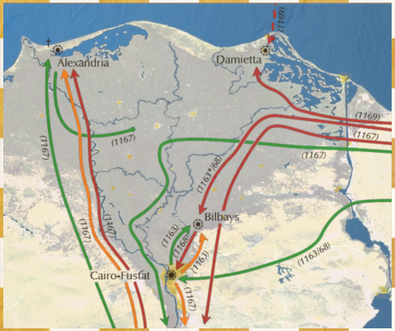
During King Amalric's reign, Jerusalem had become more closely allied with the Byzantine Empire; he married the niece of Emperor Manuel (d. 1180). In 1168, Amalric and Manuel joined forces, and invaded Egypt. A major turning point came when Amalric captured Bilbeis in early November, a city that had frustrated him on both his previous campaigns; he carried out an appalling massacre of the population. Having alienated the Egyptian population, Amalric's position quickly became unsustainable. When Nur ad-Din Zengī sent Shīrkūh and Saladid into Egypt for a third time in December 1168, they were welcomed, given money and provisions. Amalric immediately withdrew, allowing Shīrkūh to enter Cairo unopposed. The Fatimid Caliph now took matters into his own hands, arresting and executing his Sultan, and appointing Shīrkūh in his place. Nur ad-Din had seemingly accomplished his goal of uniting the Muslim states of Syria and Egypt. However, the situation was complicated by the death of Shīrkūh in February 1169, who was succeeded by his nephew Saladin; Nur ad-Din barely knew his loyal lieutenant's nephew, and soon came to distrust his ambitious underling. Few would have expected 32-year-old Saladin to retain power in Egypt for long; a foreign Sunni ruler of a state that had been unstable for decades, while under constant scrutiny from his overlord. Yet Saladin seemed to have a natural instinct for leadership, quickly gaining the reputation that would come to define his life and legacy; firm but fair, pious and devoid of pretense, generous and, when necessary, capable of breathtaking ruthlessness. Saladin almost immediately faced a revolt by the established pro-Fatimid military elites. He foiled a plot to have him assassinated, but the Cairo garrison rose in general revolt. However, Saladin quickly and effectively put down this insurrection. All the garrison's families lived in one particular suburb of the city; he ordered it to be set on fire. Afterwards, he began restructuring the Egyptian military around the Syrian units that had remained with him in Egypt, making it more effective and loyal; he also appointed his relatives to important positions throughout the government. This was not Saladin's only early test. In October 1169, Amalric of Jerusalem invaded Egypt for a fourth time, in alliance with the Byzantines once again. The joint force besieged the port-city of Damietta, by land and sea, but Saladin was well-prepared and the city held-out until famine broke out in the Christian camp; each side blamed the other for the failed campaign. This military triumph over the Christians helped secure Saladin's hold on Egypt.
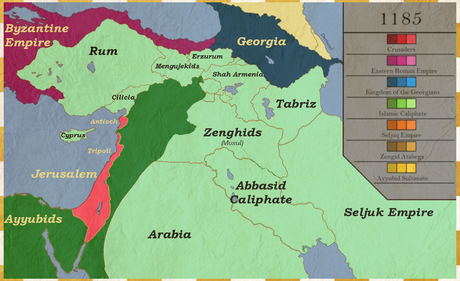
Nur ad-Din Zengī gradually realized that he had created a dangerous rival in Saladin. Clearly feeling secure in Egypt, Saladin campaigned against the Kingdom of Jerusalem in 1170. However, when Nur ad-Din planned a joint attack the next year, Saladin withdrew early from the campaign, probably preferring the Crusader kingdom as buffer between Egypt and Syria. In order to reign in his ambitious underlings, Nur ad-Din ordered Saladin to depose the Fatimid Caliph, reconciling Shi'a Egypt with the Sunni Abbasid Caliphate of Baghdad. Saladin stalled for months but eventually did obey, when the Caliph fortuitously fell ill and died; or perhaps was poisoned. Tension continued to mount, especially over the size of Saladin's tribute payments, and Nur ad-Din was on the verge of invading Egypt, when he fell suddenly ill and died in May 1174. He was succeeded by his 11-year-old son, as-Salih Ismail (d. 1181). Without waiting to be invited, Saladin announced that the boy needed a strong regent, and declared himself his guardian. He marched on Damascus, where the city-gates were opened to him amid general acclaim; as-Salih, however, had been removed to Aleppo by a rival. Saladin then proceeded to reduce other cities that had belonged to Nur al-Din, through a potent mix of warfare and diplomacy. Without a Zengid prince to legitimise his claim to Syria, Saladin carefully cultivated him image as the defender of Sunni Orthodoxy against rival faiths, using his victory over the Amalric of Jerusalem and removal of the Shi'a Caliph in Cairo to give his claim weight. After his victory over an army from Aleppo at the Battle of the Horns of Hama (April 1175), the Abbasid Caliph in Baghdad graciously welcomed Saladin's assumption of power, formally recognising him as Sultan of Egypt and Syria, as well as the Islamic holy cities of Mecca and Medina. Unfortunately, there was personal risk in this, and he twice survived attempts on his life by the Nizari Ismailis sect; known in the West as the Assassins. This secretive Shi'a sect had emerged following the Sunni Seljuk conquest of Persia in the 1040s, and established a dozen fortresses in the Alborz Mountains, with their headquarters at the virtually impregnable Alamut Castle. Over the course of two centuries, they cause havoc in the Muslim world, killing at least two Caliphs, many Sultans, and quite a few Crusader leaders. In 1176, Saladin led his army into the Alborz Mountains, but strangely abandoned the campaign after a few weeks. According to legend, assassins stole into Saladin’s tent during the night, and, rather that killing him, left a warning pinned by a poisoned dagger beside the bed of the sleeping sultan. Like countless others, the Nizari Ismailis would eventually meet their match in the Mongols. Meanwhile, Aleppo and Nur ad-Din's son remained a serious thorn in Saladin’s side, but he still found time to clash with the Crusaders. He suffered defeat trying to recover the southern fortress of Ascalon ("the gateway to Egypt") in 1177, but was victorious in the Golan Heights in 1179, destroying a new border castle being built by the Knights Templar at Jacob's Ford on the River Jordan. Saladin’s position was greatly strengthened, when Nur ad-Din's son died of illness in 1181, and Aleppo finally fell to him two years later. A Zengid prince still ruled in Mosul, but Saladin shamed him into agreeing to a truce, stating "they are not content not to fight [the Crusaders], but they prevent those who can". Salidin had now made Nur ad-Din's dream a political reality, uniting Syria and Egypt into a single Muslim power, and completely surrounding the Crusader States. In the process, he had also recreate some of the same brotherhood, discipline, and religious zeal, that had seen the first generations of Muslims conquered half the known world.
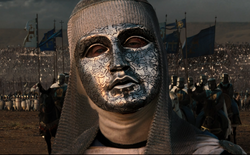
Baldwin IV of Jerusalem, known to history as The Leper King, here depicted in the film Kingdom of Heaven. Baldwin, whose body was already ravaged by aggressive leprosy, personally fought in battle against Saladin at Montgisard in 1177.
Meanwhile in the Crusader State, King Amalric of Jerusalem (d. 1174) died just a few weeks after Nur ad-Din, leaving the kingdom to his 13-year-old son Baldwin IV (1174-85). By all accounts the boy had the makings of a fine king; quick-witted, charismatic, and a skilled horseman. Unfortunately, he suffered from leprosy, though this only became evident after his ascension to the throne; he fought with his sword in his left hand, since the right was completely numb. Despite the young king’s extraordinary fortitude, his precarious health necessitated a continuous regency council, which accentuated the political wranglings between two existing factions: the so-called "noble party", the old families of the kingdom led by Raymond of Tripoli (d. 1187), who sought feudal autonomy and to avoid unnecessary conflict with the Muslims; and the "court party" led by the king's mother, and generally consisting of recent arrivals from the West such as Guy of Lusignan (d. 1194) and Raynald of Châtillon (d. 1187), who favoured war with Saladin. As Baldwin was not expected to live long or have children, the focus of his succession passed to his sister Sibylla. The perfect spouse seemed to be found in William of Montferrat (d. 1177), a cousin of both Louis VII of France and of Frederick Barbarossa of Germany, bringing the possibility of external aid. Unfortunately, he died a few months into their marriage, leaving Sibylla widowed and pregnant with the future Baldwin V. In the end, the court party outmaneuvered their rivals, and Sibylla subsequently married Guy of Lusignan (1186–1192), a vane, weak, and foolish newcomer to the East. In the meanwhile, the Kingdom of Jerusalem had become increasingly lawless, exemplify by the activities of Raynald of Châtillon. Raynald had arrived in the Holy Land with the Second Crusade, and eventually became Duke of Antioch, through a fortuitous marriage. He was always in need of funds, and launched aggressive plundering raids against Muslim territory, that scandalised even his Christian contemporaries. In 1161, he was captured captured by the governor of Aleppo. His family seemed in no rush to raise a ransom, so he was held in prison for fifteen-years. On his release in 1176. his stepson was firmly established as ruler of Antioch, so Raynald made his way to Jerusalem determined to restore his prestige and fortune, as well as revenge himself on his former captors. Another fortuitous marriage in 1177 gained him the modest fiefdom of Hebron, conveniently located near the caravan routes between Egypt and Syria. He was one of the only Christian leader to pursue an offensive policy against Saladin, making plundering raids against the caravans travelling near his domains. In his most audacious raid in early 1183, Raynald built a fleet of five ships, transported them overland to the Red Sea, and plundered his way down the Muslim pilgrimage route towards Mecca; an insult to Islam that Saladin pledged never to forgive. Despite growing tension between Saladin and the Crusaders, the peace generally held until Baldwin's death in 1185.

King Guy of Jerusalem surrendering to Saladin after the Battle of Hattin, one of the great victories of the celebrted sultan.
Baldwin IV had recognised the inadequacies of Guy of Lusignan, and, according to succession arrangements, Raymond of Tripoli became regent for Sibylla's young son, Baldwin IV of Jerusalem (1185-86). Unfortunately, the boy-king died within a year, and the court party orchestrated what was in effect a coup d’état, hastily crowning Sibylla, who in turn crowned her husband, Guy of Lusignan (1186-1192). With Jerusalem in a state bordering on civil war, the last thing it needed was someone giving Saladin a pretext to declare his long-awaited Jihad ("holy war"). But that is precisely what Raynald of Châtillon did. In late 1186, he plundered a caravan making its way from Cairo to Damascus while a formal truce with Saladin was still in place; a popular myth that Saladin's sister was travelling with the caravan is almost certainly untrue. Saladin sent an envoys to King Guy, who accepted that the attack amounted to a breach of the truce, but was unable and unwilling to compel Raynald to make recompense. Saladin immediately began to muster his forces from across his vast territories, and declared war on the Kingdom of Jerusalem; he also swore he would kill Raynald. In June, he assembled the largest army he had ever commanded, numbering around 35,000, and crossed the Jordan River south of the Sea of Galilee. At the resulting Battle of the Horns of Hattin (July 1187), the Muslims were aided by a phenomenal lack of military good sense on the part of their enemy. Saladin decided to lure King Guy into inhospitable terrain, by blocking the main road to Tiberias and sending a small force to besiege the city, which fell within a day. At a Crusader war-council, Raymond of Tripoli initially persuaded Guy not to fall into the trap. However, late that night, others changed the impressionable king's mind, accusing Raymond of cowardice. Having assembled almost every able-bodies fighting-man of the kingdom, Guy decided to risk everything on a single throw-of-the-dice. On 3 July, the Crusaders started out on the arduous journey across the Galilean mountains towards Tiberias, in mid-summer while harassed by Muslim horse-archers. With the slow progress, Guy decided that the army would not reach Tiberias by nightfall, but, with the Muslims blocking the route to nearby water-sources, was forced to pitch camp overnight on the arid plateau. Throughout an uncomfortable night, the Muslims harassed the demoralized, exhausted, and thirsty Crusaders, from their own well-supplied camp with a caravan of camels ferrying water from the Sea of Galilee. In the morning, as the march resumed towards Tiberias, Saladid order prepared piles of brushwood to be set alight and launched the bulk of his mounted archers at the Westerners, who were blinded by smoke. Although mounted elements of the Crusader army made repeated charges against the Muslim lines, only Raymond of Tripoli was able to broke through the encirclement, and Muslim horsemen carefully shepherded him away from the battlefield; he was one of the few Crusader leaders not killed or captured; it was later suggested that Raymond had been allowed to leave by prior arrangement, such was the mistrust between the squabbling Latin nobles. Without Raymond's forces, Guy's position was now even more desperate, and all discipline collapsed. The Crusaders were surrounded and, despite ferocious resistance, overwhelmed from all sides.Salidin's victory was total; every knight was slain or captured, except for Raymond and a few others. In one of the most iconic images of the Crudading Age, King Guy of Jerusalem and Raynald of Châtillon were brought to Saladin's tent. Saladin handed Guy a goblet of water, a sign in Muslim culture that the prisoner would be spared. Guy then passed the goblet to Raynald, but Saladin struck it from his hands, stating "You gave the man the drink, not I". He then charged Raynald with breaking the truce, and beheaded him with a single stroke of his sword. The king and other nobles were treated honourably and most were later ransomed, though any Templar and Hospitaller Knights were executed as Saladin feared their fighting skill and devotion to the Christian cause. To make matters worse, Saladin captured the relic of the True Cross, which despite efforts to retrieve it by Richard the Lionheart and others, the cross was never returned and eventually lost to history.
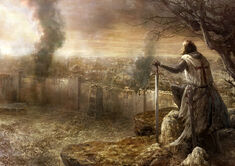
The surrender of Jerusalem on 2 October 1187, a devastating blow to the whole Crusading movement, and the event that provoked the Third Crusade.
King Guy had denuded most of the garrisons across Jerusalem to fight at Hattin, leaving the kingdom virtually defenceless. Over the next two-months, Saladin followed up his victory by occupying most of the major strongholds in the kingdom, with barely any fighting and limited plundering; he wanted to conquer a functioning kingdom. All the heavily fortified ports south of Tripoli fell one by one, including Acre, Jaffa (Tel Aviv), and Beirut. Only Tyre repulsed Saladin's siege, thanks to the fortuitous arrival of Conrad of Montferrat (d. 1192) on pilgrimage. Some historians view this as one of Saladin's few strategic blunders as it provided a bridgehead for the Third Crusade. On 20 September 1187, Saladin turned to the greatest prize of all; the Holy City of Jerusalem. Wanting to avoid bloodshed, Saladin offered generous terms of surrender, but those inside threatened to destroy the city rather than hand it over. There were only a handful of full knights in the whole city under Balian of Ibelin (d. 1193), but the city resisted assaults for nine-days, until Muslim's miners brought down a portion of the walls. With the situation hopeless, Balian rode out to negotiate the surrender of the city. Saladin's lasting reputation among Christians as a man of chivalry and honour derives above all from his treatment of the inhabitants of Jerusalem. The contrast, eighty-eight years earlier, with the behaviour of the First Crusade could not be greater. Instead of massacre, looting, and destruction, there was an orderly hand-over on 2 October 1187. A ransom was to be paid for each Christian to depart in freedom, but it was relatively small. The Christian authorities set an appalling example to the very end. The archbishop of Jerusalem, after buying his own freedom, departed with a wagon-load of the city’s treasures, rather than paying the ransom of poor Christians, who were probably sold into slavery; Saladin's brother and lieutenant, al-Adil Sayf ad-Din (d. 1218), was given a thousand of them and then set them free on the spot. The Church of the Holy Sepulchre was allowed to remain in Christian hands, while Jews and Orthodox Christian were invited to resettle in the city; Latin Christians pilgrim were allowed to enter upon paying a fee.
Third Crusade[]
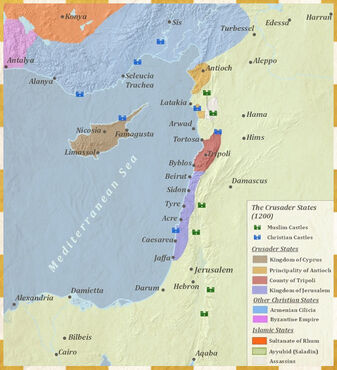
Upon hearing the news of the fall of Jerusalem, Pope Urban III (d. 1187) is said to have died of shock. His successor, Pope Gregory VIII (d. 1187), only reigned for a few months, but made his mark on history by issuing a papal bull calling for the Third Crusade (1189–92). Again the stakes were raised. Instead of the two kings who had led the Second Crusade, this time there were to be three: Frederick Barbarossa of Germany (d. 1122), Richard "the Lionheart" of England (d. 1199), and Philip II of France (d. 1223). The first rule to mobilise was Frederick Barbarossa, now nearly 70-years-old and approaching the end of an eventful reign. He set out by land for the East, in May 1189, with the largest army ever to march on a Crusade; about 100,000 in all. The last thing the Byzantine Emperor Isaac II Angelos (1185-95) needed or was capable of handling was a large Western army passing through his territory. After the death of Emperor Manuel (d. 1180), dynastic instability returned to the empire, in large part cause by growing tension with the West, especially the power and arrogance of Venice. Frederick Barbarossa had been openly hostile to Byzantium throughout his reign, refusing to honour his father's agreement for a joint campaign against Norman Sicily, and supporting separatist movements in Byzantine Bulgaria and Serbia. Meanwhile, the Crusaders were deeply suspicious of a treaty that Isaac II had made with Saladin, who promised to help curb Turks power in Anatolia. Isaac II could hardly have handled this volatile situation worse. He first granted the German army permission to cross his territory, but then panicked and threw every impediment in its way, perhaps fearful that Frederick intended to conquer Constantinople itself. But if he thought to intimidate Frederick Barbarossa, he had disastrously under-estimated the man. This was no disunited collection of Crusaders squabbling amongst themselves, but a powerful, well-disciplined army led by a decisive commander, who was not amused. In retaliation, he occupied Byzantine Adrianople, until Isaac II gave-in and transport them across the Hellespont as quickly as possible. In Anatolia, Frederick Barbarossa swept all before him, even sacking Iconium, the capital of the Sultanate of Rûm. Yet he would never see the Holy Lands. While impatiently fording the River Saleph, Frederick Barbarossa's horse slipped, throwing him into the water, where he drowned. With this, the vast majority of the massive German army aimlessly drifted home for the election of a new king-emperor; a small remnant under Leopold of Austria (d. 1194) did reach the Holy Lands. For Saladin, seriously alarmed by Frederick’s approach, the emperor's death must have seemed like act of God. For Isaac, he had achieved his goal of curbing Turks power in Anatolia, but at the cost of antagonising the West unnecessarily, and apparently confirming their long-held suspicions of Greek duplicity.
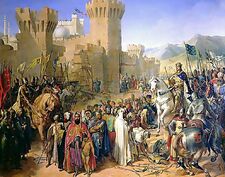
The fall of the port-city of Acre to the Crusaders was not a military disaster for Saladin. However, the loss of some seventy Muslim warship in the harbour, would decisively shift the balance of power in the eastern Mediterranean towards the Latin Christians.
The Third Crusade would have to rely on the contingents from England and France, though the English king's extensive holding in France, and the French king's desire to recover them, would pose problems that were difficult to lay aside even during a common enterprise. The two kings were very different people. Richard had only recently inherited his throne and had no particular talent for statecraft, but in war, he was a genius. On his journey to the Holy Lands, he had already captured Cyprus, from a rebel Byzantine leader on the rather tame pretext that the locals had not treated some shipwrecked Crusaders very kindly; the island was forced to pay a 50% tax to further boost Richard’s campaign coffers. In contrast, Philip II was a decade into what proved a brilliant reign, and, though no warrior, was a skilled and unscrupulous politician; he was a reluctant Crusader at best. When Richard and Philip reached the Holy Lands by sea in the summer of 1191, a modest Crusader recovery had already begun. Conrad of Montferrat had established himself at Christian-held Tyre, after his successful defence of the city against two Muslim sieges. When Saladin released Guy of Jerusalem from captivity in 1189, he attempted to take command of Tyre, but Conrad refused him entry, declaring that Guy had forfeited his rights as king at the Battle of Hattin. Undeterred, Guy gathered a few followers and besieged the Muslim-held port-city of Acre; the Siege of Acre (1189-91). The Muslim garrison defending Acre were significant, but the siege was allowed to drag-on, with Saladin focused on the apparently imminent arrival of a massive German Crusader army to the north. The arrival of the French and English kings reinvigorated the 18-month-old siege. The walls of Acre were subjected to an almost ceaseless bombardment with siege engines, while Saladin did what he could to relieve the defenders by assaulting the Christian trenches. In early-July, the besieger had a solid breach, and the exhausted Muslims garrison finally surrendered, in violation of Saladin’s orders. With victory, the Latin Christians set to quarrelling. Richard cast down the German standard from the city-walls, slighting Leopold of Austria. Then Richard and Philip quarreled over the kingship of Jerusalem, supporting Guy and Conrad respectively. In October, Philip and Leopold, frustrated with Richard, abrustly declared that the symbolic victory at Acre had fulflled their Crusading oaths and returned home.

Richard Coeur de Lion outside the Palace of Westminster
The Third Crusade thus became a straight fight between Richard and Saladin. The first order of business was settling the kingship of Jerusalem, with the decision that Guy would continue to rule, with Conrad receiving the crown upon his death; a farcical solution that failed utterly. Next, Richard set about ransoming the captured Muslim garrison from Acre, but the negotiations broke-down due to lack of trust. In August, convince Saladin was deliberately stalling, Richard ordered all 2,700 prisoners out the city-gates, and massacre them in full view of Saladin's army; Saladin responded by killing all of the Christian prisoners he had captured. With Acre secure, Richard next set its sights on the port-city of Jaffa, understanding that the Crusaders must hold the coast before an attack on Jerusalem. The first and only pitched battle between the pair occurred on the march; the Battle of Arsuf (September 1191). Saladin attempted to harass Richard's army into breaking its defensive formation in order to defeat it in detail. Richard maintained his army's discipline, until the Hospitallers broke ranks to charge the right wing of Saladin's forces. However, Richard’s military brilliance won the day, turning this indiscipline into a general counter-attack, that forced Saladin to withdraw with heavy losses. Thus Richard was able to take and hold Jaffa, threatening Saladin's hold on Jerusalem. He remained in the Holy Lands for another 12-month, but this was the peak of his Crusading success, with the leadership becoming fractious. Richard favoured seizing Ascalon to the south, thus threatening Saladin's supply-lines between Syria and his main power-base in Egypt, thus forcing Saladin to relinquish Jerusalem. However, the bulk of the Crusaders were intent on striking straight for Jerusalem, which was, after all, the original goal of the Third Crusade. Without control of the hinterland, Richard knew that even if he took Jerusalem, a city so far from naval support could not be held for long. He twice marched cautiously to within sight of the Holy City, but, with the Muslims harrassing his supply-line, was forced to retreat. In July 1192, Saladin took Jaffa, though Richard recovered the city the next month, showing outstanding personal courage against improbable odds. But in terms of the bigger picture not much had changed; the Third Crusade was a stalemate, and time was on Saladin's side. After Philip II returned to France, he began plotting against Richard’s lands. Although forbidden by the Church from acting too directly while Richard was away on Crusade, these actions were lucrative nonetheless. Thus the English king received urgent messages from home requesting his return. Richard had been in constant communication with Saladin through his brother, Sayf ad-Din. The two great men never met in person, with Saladin saying that it was unseemly for kings to meet while making war upon each other. There was nevertheless a warm cordiality and mutual respect between the two men; when Richard became ill, Saladin sent his personal doctor to tend him. In September 1192, Richard agreed a peace treaty with Saladin, recognising the territorial status-quo: the Crusaders retained a thin strip along the coast from Tyre to Jaffa, and Jerusalem remained under Muslim control. It also assured the rights and protection of Christian pilgrims visiting the Holy City, though this had been Saladin's policy even before the Crusade. Before returning home, Richard finally realised that he had to definitively settle the kingship of Jerusalem; his presence was the only thing preventing civil war between Conrad and Guy. The matter was put to a vote among the barons of the kingdom, and Conrad of Montferrat was elected unanimously; Richard's preferred candidate Guy received not a single vote. Nevertheless, only days later, Conrad was stabbed to death in the streets of Tyre; many historians suspect that Richard ordered the murder. Conrad's widow was then persuaded to marry Richard's cousin, Henry of Champagne (1192-97), while Guy was sold Cyprus in compensation. Thus ended the Third Crusade. It was not quite what had been hoped at the outset, but had put the Latin Christians of the East back on their feet, and there could always be a Fourth Crusade at some time in the future. The great Saladin died not long after the departure in March 1193, and the Muslim world fractured once again, with his empire contested and divided between three of his sons and two of his brothers.
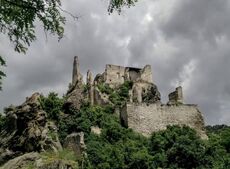
The ruins of Dürnstein castle in Austria, where King Richard was first imprisoned.
King Richard's journey home from the Crusade was to be long and costly. His first ship was forced by bad weather to put in on Byzantine Corfu, where he had to hastily make new arrangements; he had afterall just recently conquered and sold Byzantine Cyprus. His next ship was driven onto rocks in the Adriatic, near Trieste. Richard was thus forced into a dangerous land route through central Europe. At an inn near Vienna, the English king was recognised, and fell into the hands of Leopold of Austria, who had not forgotten Richard's slight at Acre. Leopold kept Richard prisoner at Dürnstein Castle for some months, before handing him over to his overlord, Henry VI of imperial Germany (d. 1197), who was also not a fan. In Europe's great game of feudal politics, Richard had often supported enemies of the German king-emperors, such as rebellious Henry "the Lion" of Bavaria. Henry was also in need of money to assert his claim to Norman Sicily. Although the pope excommunicated him for it, Henry held Richard for ransom for another year at various castles. According to legend, an English minstrel called Blondel travelled from castle to castle throughout Germany searching for the king, by loudly singing a song that the pair had written together. Philip II of France and Richard's younger brother, John, tried to prolong his captivity, but Richard was eventually released to the English in February 1194 for a colossal ransom; Philip warned John with a famous message, "Look to yourself, the devil is loosed". The staggering cost of Richard's ransom, more than twice the annual income of England, would sow the seeds of the troubled reign of John I of England (d. 1216), which culminated in the signing of Magna Carta. It also supposedly provoked Robin Hood to take to Sherwood Forest, and engaged in a spot of wealth redistribution.
Western and Byzantine Tensions[]

The Latin cross and the Orthodox cross. In the Orthodox variation the top crossbeam represents the plate inscribed with the phrase "King of the Jews", and the bottom one, a footrest. The footrest slants upward toward the penitent thief Dismas, and downward toward impenitent thief Gestas.
The first three Crusades had significantly increased contact between the Latin West and Orthodox East, but familiarity, however, did not lead to a greater understanding between the two cultures. It may have been too obvious that many Byzantines thought of Latin Christians simply as greedy barbarians, whose kings and even clergys were descendents of the Germanic tribes that had wrecked the Western Roman Empire. The Byzantines maintained a strong sense of political, cultural, and even religious superiority, the defenders of Christendom, the rock which stood against the tide of Islam sweeping in from the east. It was hard for them to accept the reality that their empire might now be just one among many strong Christian states. No emperor had kindly received Crusading armies, always suspecting that their secret aim was to conquer Constantinople itself. It was certainly too obvious that the Byzantines had little sympathy with the Crusader States, which always enjoyed a warm glow of religious frontline commitment in the minds of Western observers. Constantinople's willingness to engage diplomatically with the infidels, or even ally with them if it served the emperor's interests, seemed to the Latins like a corrupt betrayal of the faith. There were genuine religious differences too, which seemed horrible to Byzantines, not least Crusading ideology itself. Early Christians, a religion dedicated to the injunction of "love thy neighbor as thyself", were not alien to the use of violence. In the 4th-century, St. Augustine of Hippo's seminal work, The City of God, developed a concept of Just War, which maintained that aggressive war was sinful but that limited uses of war, typically defensive in nature and without excessive violence, would be considered acceptable. Even then, the fighting and killing itself was not considered a spiritually virtuous act in any way. Before the 11th century, Christianity had no concept of Holy War, and then it only developed in Latin Christianity due to its unique ego-political history. During the 9th and 10th centuries, pagan invasions by the Vikings and Magyars led to the emergence of terminology such as "enemies of God". Pope Alexander II (d. 1073) used similar provocative language when calling for European knights to support the Reconquista against Muslim Spain; "One may justly fight against those [the Muslims] who persecute Christians and drive them from their towns and their own homes." Pope Urban II (1099) then drastically altering the Latin Church's attitude towards violence, by inviting knights to gain remission of sins through participation in the Crusades; a concept that was alien, even heretical, to the Eastern Chruch. Meanwhile, for Western Europeans, the Crusades bound them together in a great moral and spiritual enterprise. It fed their own sense of identity and cultural superiority, and they had begun to close themselves off to alternative values and practices. The Western all too evidently did not see Byzantium as a part of their civilization. The view that Greeks were duplicitous, decadent, over-clever, and ungrateful cowards became much stronger in the 12th-century; even their religious practices were suspect, for the Great Schism had been in effect now for a century-and-a-half. The tone of awe at Constantinople’s grandeur and wealth, was by now heard much less often in Western sources. And that Byzantium’s effective and sophisticated fiscal system might be a useful model for cash-strapped Western governments was not heard at all.
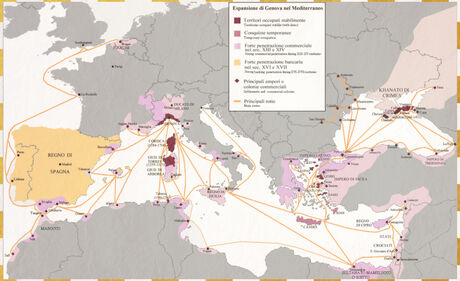
The Byzantine Empire did benefit from the First Crusade, re-establishing imperial rule on the western and south coast of Anatolia. The emperors did not retake the Central Anatolia from the Sultanate of Rûm, and barely tried to; the only serious attempt ended in defeat at the Battle of Myriokephalon (1176). The Anatolian plateau thus became Turkish forever, though Byzantium was not again threatened from the east until the very different world of the 14th-century. But the greatest beneficiaries of the Crusades were the Italian Maritime Republics, especially Venice, Pisa and Genoa. As well as providing naval support for Crusading armies, their ships arrived at Crusader States with much needed manpower and material supplies. Italian merchants had long engaged in trade in the Eastern Mediterranean, but it increased phenomenally during this period. As well as making profits, they established trading-colonies; typically small gated enclaves within a city. At the same time as Italian port were serving as the launching pad to wrestle the Holy Land from Muslim control, the republics successfully claimed neutrality and continued to trade extensively with the Islamic world from Syria to Spain. Trade generated profits that were in turn reinvested in ever great fleets to protect and enlarge extensive trade-networks across the Mediterranean and the Black Sea.
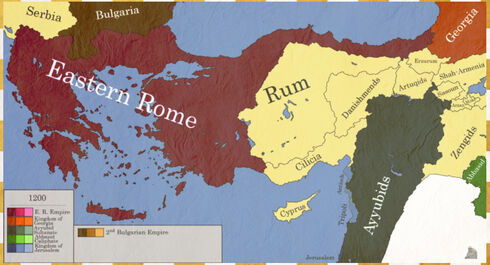
Under Emperor Alexios, his son, and grandson, the Byzantine cycle of dynastic instability, coups, and revolts ended for a century. The only ominous cloud on the horizon was the cuckoo in her nest, the Republic of Venice. Venice had become a part of the Byzantine Empire during Justinian’s conquest of Italy in the late-6th-century, but asserted its independence in 726, as the imperial grip on Italy first began to slip. Yet the two parties maintained strong ties through trade, with the Venetians quickly adapting to the role of middlemen between the East and West; Byzantine merchants would bring luxury goods from the East, for Venetian traders to then distribute them in the West. The downhill turn in this relationship began in 1082, when Emperor Alexios granted Venice expansive trading priviledges within the empire, in return for desperately needed naval support against Norman adventurer Robert Guiscard. The agreement made Venetian merchants effectively exempt from taxation, and granted them their own district in Constantinople. Hard-nosed businessmen, the Venerians quickly gained a reputation for arrogance and lawlessness, as well as for using their tax exemptions to outbid native Byzantine merchants. In the early-12th-century, the republic built a large national shipyard that became known as the Venetian Arsenal; one of the largest industrial complex in Europe before the Industrial Revolution. Building new and powerful fleets, the Venerians established a virtual stranglehold on commercial shipping within the empire; Venice, it could be said, was a parasite feeding on an economic host of enormous potential. Emperor Alexios had never intended for Venice's trade priviledges to be permanent, and his son, John II Komnenos (1118-43), refused to renew the agreement in 1124. In retaliation, the Venetian Doge launched a punitive naval expedition against Ionian and Aegean coast, until John was forced to come to terms. Emperor Manuel (1143-80), inheriting the same problem, sought to curb Venetian power by favouring their main commercial rival, Genoa. One day in early-1171, a Venetian mob effectively ransacked the Genoese quarter, looting and killing the Genoese, until the imperial guard arrived to restore order. The emperor responded to this blatant act of disobedience by arresting every single Venetian merchant he could find across the empire, and confiscating their property; some 10,000 men, women, and children. Although the Venetian Doge favouring caution, outrage in Venice itself swung popular opinion in the favour of full scale war; the Byzantine-Venetian war of 1171. A Venetian armada besieged the port-city of Euboea, and, seeing this, Manuel opened negotiations. The emperor, however, had no mind for peace, and was simply stalling while he organized a fleet capable of confronting the Venetians. His ruse worked better than expected. A devastating plague broke out in the Venetian camp, which killed thousands within the first few days. The fleet eventually limped home, having barely fired a shot. This may have been a gratifying moment for the Byzantines, but the Venetians would not forget this humiliating defeat. Enrico Dandolo, the future Doge and architect of Fourth Crusade, served as a envoy to during the war, and began to think in terms of putting Constantinople under Western control as the only means of securing Venetian interests in Byzantine trade. Emperor Manuel is something of a tragic figure. More than any of his predecessors, he appreciated that Byzantium could not presume to ignore or offend the new powers in the West. He handled the Second Crusade adroitly, only to be unfairly scapegoated by the French king for its failure. He worked dilligently to forge a strong personal relationship with Conrad III of imperial Germany, only for his diplomatic efforts to collapse on Conrad's death in 1152; his successor, Frederick Barbarossa, refused to honour his father's agreement with what he liked to insultingly referred to, “the kingdom of the Greeks”. The energetic emperor then made common cause with the King Amalric of Jerusalem against Fatimid Egypt in the build-up to the Third Crusade. but the campaing to come to nothing due to Crusader indiscipline and the rise of Saladin. Certain aspects of the Western way of life seemed to appeal to Manuel; his first and second wives were Westerners. But to his own subjects, the emperor always seemed just a little bit too interested in those far off lands and their barbaric customs.
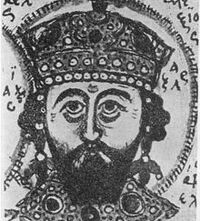
Alexios III Angelos, whose reign marked the low-point of Byzantine decline prior to the Forth Crusade, with a state on brink of financial ruin, and an army neglected to the point of uselessness.
On Manuel’s death in 1180, Byzantium endured a new round of dynastic instability and incompetent rulers. He was succeeded by his 11-year-old son, Alexios II Komnenos (1180-83), with the boy's Western mother as regent, Maria of Antioch (d. 1182). The Byzantines feared the worst, and it did not take long for their suspicions to be confirmed. Venetian trading privileges were restored, and their ships soon returned to the waters of the Bosporus, choking-off native Byzantine trade once again. As a wave of anti-Western feeling swept Constantinople, Andronikos Komnenos, a cousin of Manuel, seized the opportunity to grab the crown for himself. Posing as the champion of Byzantine patriotism, Andronikos' advance on Constantinople proved irresistible; people cheered him as he marched, and armies sent against him defected without a fight. Entering the capital, he easily overthrew the foreign woman sitting on the throne. As emperor, Andronikos I Komnenos (1183-85) had all the brilliance of his family, but none of the restraints; violence in his mind was the solution to every problem. The Venetian problems was as bad as ever, and he solved it by massacring every Italian to be found in Constantinople; perhaps as many as 60,000 people were killed or forced to flee. This only worsened the image of Byzantium in Western eyes, and earning the eternal animosity of Venice. Next, he resolved to suppress corruption, to protect the average Byzantine from the rapacity of their superiors, in the process checking the power of the nobility who might threaten his own throne. There was justice in his reforms that, but also brutality; hundreds of offenders were executed regardless of their rank. But the inevitable result was plot after plot to overthrow him. Before long the paranoid emperor was seeing enemies in every shadow, and Constantinople was plunged into an orgy of blood and suspicion. In September 1185, Andronikos moved to arrest a nobleman called Isaac Angelos, a member of the extended imperial family. However, Isaac sought refuge in the Hagia Sophia and appealed to the congregation to help him. By now, the population had had enough, and a tumult rapidly spread across the whole of Constantinople. The emperor was caught by the mob trying to flee the city, and suffered a prolonged and brutal death; a dying Andronikos was heard to say, "oh lord, why does thou trample a poor reed that is already quite broken". His death was mourned by none, but for all his flaws, Andronikos had at least some redeeming virtues; Isaac II Angelos (1185-95) had none. Isaac inaugurated his reign with a lavish wedding to the daughter of King Béla III of Hungary, his most powerful neighbour. More parties followed, and a promised hefty pay-raise for the entire army. But this reckless spending had to be paid for somehow, and his solution was new oppressive taxes. The result was a disastrous wave of revolts: Bulgaria reasserted its independence as the Second Bulgarian Empire (1185–1396); Slavs of the western Balkans eventually established their own state, the Kingdom of Serbia (12171346); and a rebellious Byzantine general seized Cyprus, which was later wrestled from the empire by Richard the Lionheart in 1191. Isaac's new taxes actually resulted in even less revenue, so he resorted in the words of a contemporary, "to selling government offices like vegetables in a market"; the corruption banished by Andronikos came back in all its forms. Matters were not made easier by the fall of Jerusalem in 1187, and arrival of the Third Crusade two years later. Isaac could hardly have handled the situation worse, making Byzantium’s military weaknesses all too evident and seemingly confirming the West's already deep suspicions about Greek duplicity. The last five years of Isaac's reign was spent in fruitless wars against Bulgaria, until the army, tired of broken promises and no pay, proclaimed his brother emperor as Alexios III Angelos (1195–1203); Isaac was blinded and imprisoned. It soon became clear that Alexios, if anything, was even worse. An incompetent degenerate with no interest in state affairs, he stood idly by as Anatolia was once again overrun by the Turks, while the Bulgarians and Serbs descended unchecked to ravage the Balkans. The emperor's chief admiral, his brother-in-law, reportedly sold the imperial fleet down to the very nails to enrich himself. Then around 1201, Prince Alexios, the son of the deposed Isaac II, somehow escaped from Constantinople, and headed west to drum-up support to overthrow his usurper uncle. He found it in the most unlikely of places, the Fourth Crusade.
Fourth Crusade[]
The Fourth Crusade (1202-04) was one of the most remarkable and controversial events in the entire medieval history. Though a bizarre combination of cock-ups, financial constraints, Venetian cynicism, and Byzantine in-fighting an armed expedition, launched by the papacy, sacked the largest and most sophisticated Christian city in the world. The prominent historian Steven Runciman famously wrote, “There was never a greater crime against humanity than the Fourth Crusade.” More recently in 2001, Pope John Paul II (d. 2005) issued a formal apology on behalf of the Catholic Church.
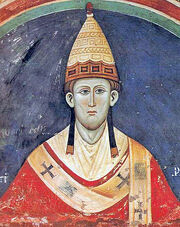
Pope Innocent III, one of the most powerful and influential of all the medieval popes.
The election of young, charismatic, and strong-willed Pope Innocent III (1198-1216) reignited Crusading zeal across Latin Christendom. The political situation in Europe at the time was complicated, and, in Pope Innocent's mind, was an opportunity to increase the power, prestige, and influence of the Church. The most significant recent event was the unexpected death of Henry VI of imperial Germany (d. 1197), which ushered-in almost two decades of political instability. For a century or so, the only thing keeping papal ambitions in check had been the power of the Holy Roman Empire. Meanwhile, Richard "the Lionheart" of England (d. 1199) and Philip II of France (d. 1223) were busy waging war against one another, while the Christian kingdoms of Spain were racked by internal strife over the efforts of Alfonso VIII of Castile to dominate the other kings. Pope Innocent thus found himself without a strong secular rival, a perfect opportunity for the Church to reassert control over the Crusading movement. Less than six months into his papacy in August 1198, Innocent issued a papal bull calling for the Fourth Crusade (1202–04). As previously, those who went to the Holy Land to fight the infidels would receive a remission of their sins, but Pope Innocent added another innovations. Believing that the previous Crusades had suffered from inadequate funding, he now extended this "benefit" to those who gave the necessary money to fund the knights who went in their stead; this idea that personal salvation could be bought for money would set a dangerous precedence. The Pope’s timing was not the best, with Europe's most powerful kingdoms busy with their own affairs. Still, a good number of second-tier nobles were inspired to take the cross at a tournament held in northern France by Thibaut of Champagne. Thibaut was elected leader, but he died in 1201, and the barons turned to Italian noble, Boniface of Montferrat (d. 1207). Perhaps significantly, given future events, Boniface had close family connections with the Byzantine Empire: his cousin was married to a daughter of the deposed Byzantine Emperor Isaac II Angelos. Indeed, all of the leaders tended to be from families that already had a connection to Crusading and the Latin kingdoms in the East, and their motivations for setting out on the Fourth Crusade were not the purist; for instance, Thibaut's brother, Henry of Champagne, had until recently been king of Acre. Boniface and the other leaders decided that the objective of the Crusade would not in fact be Jerusalem, but Egypt; seen as the soft underbelly of the Muslim world, isolated from the heartland of Islamic power in Syria and Iraq, and a rich prize as the commercial powerhouse of the eastern Mediterranean; this fact was widely advertised to the rank-and-file. An attack on Egypt would clearly be a maritime enterprise, and a delegation was sent to negotiate transport with the Republic of Venice. This of course was a rather expensive option, that even the English and French kings had struggled to afford during the Third Crusade. At the time, the Venetian Doge was the remarkable Enrico Dandolo (d. 1205). In his mid-80s and completely blind, he had boundless energy, Machiavellian cunning, and personal enmity towards Byzantium; he well-remembered his undignified expulsion from Constantinople during the disastrous Byzantine-Venetian War of 1171 and the massacre of Latins of 1182. As a hard-nosed businessman, Dandolo drove a very hard bargain: Venice would provide some 240 ships and provisions for an estimated 33,500 Crusaders, in return for an immense sum of money upfront and a share of any spoils. Muslim Egypt was a major Venetian trading partner, and it is likely that Dandolo had no intention of ferrying the Crusaders to Egyptian territory from the very start. But the hard facts of commerce were soon playing into his hands.
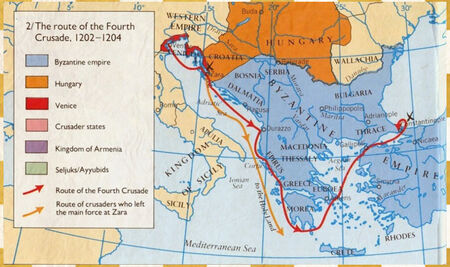
When the Crusading army arrived in Venice in May 1202, it was far smaller than had been expected; about 12,000 men instead of 33,500. And despite Pope Innocent's best efforts, his donation chests had not raised as much money as he had hoped. This was a serious problem. The Venetians had virtually cease all other commercial activity for a year to prepare this expedition, and would not let the Crusaders leave without paying the full amount agreed to. As the Crusaders pondered returning home in debt and disgrace, Doge Dandolo proposed a solution. The port-city of Zara on the eastern Adriatic coast, a crucial source of lumber for Venetian ship-building, had recently shifted allegiance from Venice to Hungary. Dandolo offered to defer the debt, if the Crusaders would do them the favour of recovering Zara on the journey to "Egypt". This was a highly controversial proposal; Zara was a Latin Christian city under the protection of king Emeric of Hungary (d. 1204), whose family had a rich association with the Crusading movement; his uncle had been among the leaders of the Third Crusade. Many of the Crusaders were opposed to attacking Zara, and some returned home or made their own way to the Holy Lands; notably the father of Simon de Montfort. However, the bulk of the army agreed. Although the defenders of Zara hung crosses from the city-walls, the city was nevertheless taken and sacked in November 1202. Pope Innocent III was not best pleased to hear the news, and promptly excommunicated the Crusaders and the Venetians. However, fearful of jeopardising the Crusade, he quickly rescinded the excommunications against all non-Venetians in the expedition.
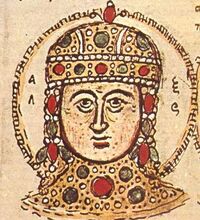
Byzantine Emperor Alexios IV, political ineptness seemed to run through his family.
Having gotten off to a bad start, the Fourth Crusade now headed down an even darker path. While over-wintering in Zara, Enrico Dandolo and Boniface of Montferrat opened secret negotiations with Prince Alexios Angelos, the son of the recently deposed Byzantine emperor. Boniface's cousin Philip of Swabia was the prince's brother-in-law, while Dandolo was determined to secure Venetian interests in Byzantine trade. Prince Alexios had another astonishing offer to put to the Crusader army: he would pay the entire debt owed to the Venetians, and provide 10,000 Byzantine troops for the Crusade, if they would sail to Constantinople and restore his father to the imperial throne. This was a tempting offer for an enterprise that was short on funds. The idea had long been gaining ground in the West that conquering Constantinople would solve any number of problems: that controlling Constantinople would help in the recovery of Jerusalem; that the Pope might achieve the supremacy over the whole of Christendom; and that the Crusader knights would gain revenge on the duplicitous Byzantines for supposedly hampering the previous Crusades. Indeed, Frederick Barbarossa had openly threatened to attack Constantinople during the Third Crusade, while his son, Henry VI, had expansionist policies against Byzantine territory before his untimely death in 1197. Doge Dandolo was a fierce supporter of the plan, though as someone who knew the finer details of Byzantine politics, he almost certainly knew that Alexios' lavish promises were false. Most of the Crusade's leaders, encouraged by Dandolo's bribes, accepted the plan; again there were dissenters, such as Renaud of Montmirail, who sailed on to the Holy Lands. For the rank-and-file, the alternative to agreeing was stark; returning home overland through hostile Hungarians territory. The Crusaders did seek the approval of the Pope Innocent for the diversion. The pope hedged and issued a vague response against any more attacks on Christians, but he did not condemn the scheme outright. It may not have all been so cynically planned as it turned out. The Crusaders would depose an illegitimate emperor in Western eyes, clear their debts, and then continue on to Egypt: the dysastic principle, so important in the West, was never strong in Byzantium.
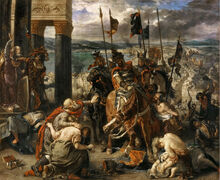
The Entry of the Crusaders into Constantinople
When the 20,000 strong Crusader-Venetian army arrived at Constantinople in July 1203, Emperor Alexios III was caught completely unprepared. To threaten the city, they first needed to enter the imperial harbour, blocked by a massive chain across the Golden Horn. The Crusaders thus laid siege to the Tower of Galata, which held the northern end of the chain. The emperor had more than enough troops to sally out, and drive-off the attackers, but dithered and, when he did finally take action, quickly lost his nerve. When Galata finally fell, leaving the imperial harbour wide open, Alexios III abandoned his subjects, and fled the city into exile with a good chunk of the imperial treasury. The next morning the Crusaders were suprised to find the Byzantine court had deposed their runaway emperor, released the blinded Isaac II Angelos, and proclaimed him emperor; the Crusaders insisted that his son be raised to co-emperor as Alexios IV Angelos (1203-04). With this achieved, the Fourth Crusade should have been able to continue on its way. The new emperor soon realised that his grand promises were impossible to keep, though he did raise half the money by appropriating treasures from the Church. For four months, the increasing impatience in the Crusader camp outside the city, was only matched by growing resentment within the city. Anti-Latin feeling had been endemic in Constantinople for decades, and, in January, finally boiled over against an emperor who owed his throne to Latins. An influential court official took advantage of riots in the capital to imprison Alexios IV, and seize the throne as Alexios V Mourtzouphlos (February-April 1204); Isaac II apparently died of shock, while Alexios IV was strangled a few days later. Cheated of their promised reward, the Crusaders and Venetians were simply in too deep to now pack-up and go home. After a long period of debate, to convince themselves that their cause was righteous, they declared war on Constantinople. Although Innocent III had demanded that they not attack the city, the papal letter was suppressed by the clergy. On 8 April 1204, the Crusaders began assaulting the lower sea-walls of the imperial harbour. The defenders held out for four days, but then the Crusaders succeeded in capturing the Blachernae section of the city-wall using platforms attached to the masts of their ships. Mourtzouphlos tried to rally the people to its defence, but the city was now in a panic, and he fled on the night of 12 April 1204, leaving Constantinople under Crusader control; he was later captured, blinded, and then executed by the new Latin regime.

The original Horses of Saint Mark that were looted from Constantinople are today displayed inside St Mark's Basilica in Venice. Replicas adorn the outside.
Inviolate since the days of Constantine the Great, the Crusaders sacked Constantinople for three horrible days, in an orgy of destruction that even the ancient Vandals would have found hard to imaginable. They looted and vandalized all they could lay hands on in the rich capital of their Christian co-religionists. Despite their oaths, they ruthlessly violated the city’s churches and monasteries; even the tombs of the Justinian the Great was not spared. Countless historically important artworks were destroyed merely for their material value, such as a magnificent bronze statue of Hercules by the court sculptor of Alexander the Great. The civilian population was not spared the Crusaders' ruthless lust for spoils and glory; thousands were killed in cold blood, while women including nuns were raped. Only Doge Dandolo seems to have retained control over his men. Rather than wantonly destrustion, the Venetians looted treasures, among them the famous bronze horses of the Hippodrome were carted-off to adorn the façade of St Mark's Basilica in Venice, where they remain today. One breathless French eyewitness boasted that two-thirds of all the wealth in the world had been in the city. Another reported that, when a fire got out of control, it destroyed more buildings than were to be found in the three greatest cities of France. The Fourth Crusade never reached within a thousand miles of the Holy Land or indeed Egypt. After the dust settled, the Crusaders and their Venetian allies carved up the Byzantine Empire. Boniface of Montferrat was outmanoeuvred by the Venetians, and Baldwin of Flanders (d. 1205) was elected the first ruler of Latin Constantinople (1204-61). Boniface reluctantly accepted the result and went on to conquer Thessalonica, as the centre of his own feudal state. The Venetians laid claim to several coastal cities and island, which became the basis on their almost complete dominance of the eastern Mediterranean. Pope Innocent III, the man who had launched the ill-fated expedition, issued a stinging rebuke, excommunicating the Crusaders. Although perhaps heart-felt, he soon accepted the new situation remarkably as "the will of God", recognising the new Latin bishops of the conquered lands, and accepting piles of stolen treasures from penitent Crusaders. The idea that conquering Constantinople would help in recovering Jerusalem proved an illusion. Indeed, the opposite was true, with the fragile patchwork of petty Latin realms siphoning off much of Europe's Crusading energy. Pope Innocent's dream of healing the Great Schism of 1054 proved erroneous too. The deep sense of betrayal, so quickly forgotten by the West, endured in the memory of their Greek co-religionists. Many historians believe that the sack of Constantinople in 1204 contributed far more to the schism than the events of 1054. The Fourth Crusade led to Latin rule in Constantinople that lasted only sixty years. The Byzantine government survived in exile at Nicaea, with offshoots at Epirus in Greece and Trebizond on the Black Sea. To leave Constantinople in foreign hands was unthinkable, and Michael VIII Palaiologos (d. 1282) recaptured it in 1261. Byzantine emperors continued to rule in Constantinople for another two centuries, but their story makes for depressing reading. The "Queen of Cities", that had once dripped in gold, was now impoverished, weak, and isolated. And by concentrating on Constantinople, the eastern provinces were neglected. By the 1280s, Turkish tribes, driven westward by the upheaval of the Mongol onslaught, were plundering the fertile valleys of western Anatolia, and beginning to carve out small principalities, among them the Ottoman Turks.
Later Crusades[]
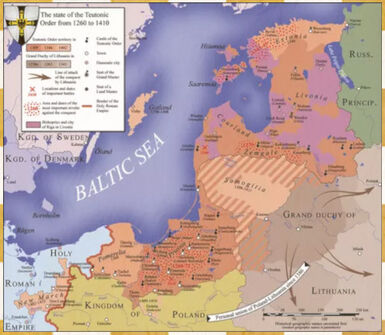
The Fourth Crusade was the last of the major expeditions launched by the Papacy, but it far from discredited the Crusading ideal. Rather, it legitimised the idea that Crusading did not have to be about the Holy Land; any enemies of the Church were now fair game.
In the 13th-century, Pope Innocent III called for a military campaign to wipe out what he viewed as heresy in southern France; the Albigensian Crusade (1209-29). Cathar heretics in the heart of Christendom was held to be even more dangerous than the faraway Muslims; also known as Albigensianism from the city of Albi where it flourished. This was part of a far wider movement, a reaction to the often scandalous and dissolute lifestyle of the high clergy. The Cathars were certainly not Catholic, but there is some doubt whether they should really be regarded even as heretics. Their theological beliefs seem to have been dualist, that the Earth was a constant battleground between the good God of the spiritual world and the Devil of the material world; or maybe that was only in the minds of Inquisitors, much as witchcraft confessions later. In truth, they were probably as pure and harmless a group of innocents as ever existed. Their priests rejected all material creation as evil, living in great austerity, imposing no tithes (church taxes), regarding men and women as equals, and abstaining from meat and from sex. But the Cathars rejected papal authority, and that was all that really mattered. Northern French nobles and their supporters streamed southward with great enthusiasm; and brutality. As with the Crusades to the East, the passion of outraged piety was inextricably mixed with greed; a chance to grab land without traveling far from home. Philip II of France had his own reason for supporting the Crusade, to extend royal authority into south of France. For all its brutality, the Albigensian Crusade failed to destroy the Cathar heresy, which survived as an underground movement well into the 14th-century. This prompted the establishment of the first Inquisition in 1234 to uproot the movement with all its terrifying efficiency. A somewhat similar Crusade against "heretics" was launched against the independent Bosnian Church; the Bosnian Crusade (1235-41). In truth, Bosnia simply lay in something of a no-man's land between Catholic Hungary and Orthodox Serbia, and the Crusade was motivated to satisfy Hungarian expansionism. Meanwhile, the Christian Reconquista (718-1492) of Muslim Spain pre-dates the Crusading Age, but was at first merely a war of conquest. Not until the First Crusade did it significantly shift in meaning toward a religiously justified war of liberation. In 1095, Pope Urban II tried to persuade the Spaniards fighters to stay in the Peninsula rather than joining the armed expedition to conquer Jerusalem, saying that their contribution for Christianity was equally important, and promising them the same indulgences. The popes called European knights to join the effort, though foreigners tended to desert because of the tolerance the Spanish often demonstrated to the defeated Muslims. In 1147, in the midst of the Second Crusade, Bernard of Clairvaux persuaded Pope Eugenius III that the German conflict with the pagan Slavs, of what is now north-eastern Germany bordering the Baltic Sea, was a holy war analogous to the Reconquista. The Northern Crusades (1147-1290) was a whole new facet of Crusading; the forced conversion of non-Christians as opposed to liberating territory held by infidels. Its motivation was much more blatantly economic; the acquisition of new lands and serfs, and the control of Baltic trade routes. The Teutonic Knights, a military-religious order originally founded in the Holy Lands, provided much of its shield and cutting-edge. The order in effect carved-out their own feudal kingdom in Prussia, and then moved on to what is today Lithuania and Estonia; the State of the Teutonic Order (1226–1525).
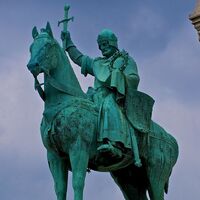
King Louis IX of France, Basilica of Sacré-Cœur of Paris. He went on two crusades: in his mid-30s in 1248, and then again in his mid-50s in 1270.
Yet the Crusading movement was far from finished with the Holy Lands. The repeated failure of the organized Crusades to reclaim Jerusalem led to frequent and sometimes bizarre manifestations of popular piety, such as the so-called Children’s Crusade of 1212. After having allegedly received divine instruction, a 12-year-old German shepherd-boy declared that his purity would succeed where the adults had failed. More specifically, he would march to the Mediterranean where the sea would part allowing him to walk to the Holy Lands. Not to be outdone, the French soon had a youth of about the same age preaching a similar message. Children and young adults flocked in their thousands to join these great adventures. Many of the German children died trudging through the Alps, with the survivors distressed when the sea failed to part for them at Genoa; a few straggled home. The French children were even less fortunate. When the sea failed to part at Marseilles, merchants offer to ferry them to the Holy Lands, and then sold them to Muslim slave-traders. Organized Crusading did not resume until the Firth Crusade (1217-21). The idea of capturing Egypt, in order to break Muslim power before turning to Jerusalem, was the now accepted strategy among Crusade leaders. Despite the successful siege of the port-city of Damietta, the Crusaders lack of regard for the local condition and proper supply-lines spelt their doom. The river Nile was flooded, halting their advance and retreat, and the entire army was forced to surrender and relinquish Damietta. The Sixth Crusade (1228-29) saw diplomacy achieve what warfare had not. Frederick II of imperial Germany (d. 1250) launched a campaign of forceful negotiation that regained some Christian control over Jerusalem, with the proviso that Muslim pilgrims could freely enter the city. The Ayyubid Sultanate of Syria and Egypt had its own internal problems at that time, and Jerusalem was of no military or economic value, making it a cheap bargaining chip to avoid a distracting war. With the benefit of hindsight, the Fifth Crusade was one of the more successful expeditions, but it left the pope feeling cheated by the lack of any actual fighting; the papacy became Frederick's most implacable foe for the rest of his reign. The pious Louis IX of France (d. 1270) dominated the final phase of the Crusading Age. In the Seventh Crusade (1248-50), Louis repeated the strategy of the Fifth and achieved only the same miserable results; the capture of Damietta, defeat at the Battle of Al Mansurah (February 1250), and the surrender of the entire army. This time the French had to pay a hefty ransom for the return of their king. Louis would have another go in 1270, but died of an illness before the Eighth Crusade (1270-72) had even properly begun. Prince Edward (d. 1307), the future king Edward Longshanks of England, and a small retinue did continue to the Holy Lands; sometimes called the Nineth Crusade. This was the last significant Crusading effort and mainland Crusader States were finally extinguished in 1291.
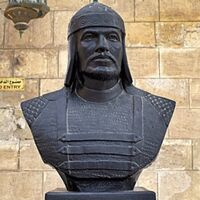
Bust of Sultan Baybars in the National Military Museum in Cairo, whose reign paved the way for the end of the Latin Crusader States.
In the 1250s, a new threat to both Christians and Muslims appeared in the Middle East in the form of the Mongols. Having already displaced the Khwarezm Sultanate of eastern Persia, a massive Mongol horde crossed the Oxus River on New Year’s Day 1256, under Hulagu (d. 1265), a grandson of Genghis Khan. Hulagu completed the conquest of Persia, in the process destroying the Nizari Ismailis sect (known in the West as the Assassins), who lost their supposedly impregnable stronghold of Alamut in November 1256. Then in January 1258, the horde appeared below the city-walls of Baghdad. The Abbasid Caliph risked the impossible and refused to surrender, believing Allah would not allow great city to fall to the invaders; Baghdad was besieged and brutally sacked. Aleppo and Damascus then fell easily into Mongol hands the next year. The Latin Christian coastal plain and the route south to Muslim Egypt, now seemed open to them. Meanwhile, the Abbuyid Sultanate (1171–1260), founded by Saladin and ruling over Egypt, Syria, western Arabia, and most of Palestine, survived the celebrated sultan's death in 1193. Saladin's his sons contested the succession, but his brother al-Adil Sayf ad-Din (d. 1213) ultimately became the sultan in 1200. In the 1220s, Abbuyid power began to slip, with the loss of western Arabia. Under Frederick II, the Sixth Crusade (1228-29) capitalized on this internal strife to regain some Christian control over Jerusalem. Although the agreement was virtually meaningless in political and military terms, Syrian cities used it to provoke anti-Ayyubid sentiment and assert their independence. Sultan as-Salih Ayyub (d. 1249) finally restored the unity of the Sultanate through building a strong and loyal army based around the Egyptian Mamluk slave-soldiers. as-Salih Ayyub died in the midst of the Seventh Crusade (1248-50), and was succeeded by his son, al-Mu'azzam Turanshah (d. 1250). However, as Turanshah was in Syria, his mother Shajar took charge of the successful defence of Egypt, with her Mamluk generals Aybak and Baybars. With the Crusade defeated and Louis IX of France captured, a power struggle ensued between Shajar and her son Turanshah, that ended with Turanshah's assassination. Political pressure for a male riler led to Shajar's marriage to the Mamluk commander, Aybak (1250-57), founder and first sultan of the Mamluk Sultanate (1250-1517). Then in 1260, a Mongol envoy appeared beneath the city-walls of Cairo demanding its submission. However, the Mamluks knew that Hulagu had withdrawn to Mongolia with the bulk of his troops, upon the death of the Great Khah, Möngke Khan (d. 1259). Thus they killed the envoys and prepared for war. At the resulting Battle of Ain Jalut (September 1260), the Mamluks won through superior numbers and by mirroring traditional Mongol tactics. The Mamluk vanguard provoked the Mongols with hit-and-run tactics, and then feigned retreat to draw them into the highlands, to be ambushed by the rest of the Mamluk forces concealed among the trees. The Mongol army fought very fiercely and aggressively to break out, but, when their commander died, they fled the field. This battle was not the first major defeat for the family of Genghis Khan, but it was the first time they were permanently prevented from expanding their empire; Egypt, Palestine and Syria were preserved for the Mamluk Sultanate, while Mesopotamia and Persia remained part of the Mongol world. In this league, there was no room for the few tiny Latin Crusader States. The beneficiary of the victory at Ain Jalut was Baybars (1260-77), who assassinated his predecessor, to become sultan of Egypt. These Mamluk sultans were not a family line, like a traditional dynasty. They were warlords within a military oligarchy, who fought and schemed against one another to be acclaimed sultan. Baybars was ruthless, utterly lacking the generous chivalry that the Crusaders had admired in Saladin. Seized as a boy from the Kipchak Turks of the Caspian steppe, he had been brought to Egypt to be slave-soldier. His talents had enabled him to rise to high command in the Mameluke army. It is said he had laid out the overall strategy of the Battle of Ain Jalut. To legitimize his usurption, Baybars found a refugee Abbasid prince, who had escaped the fate of his house, and proclaimed him Caliph in Cairo, who in turn recognised Baybars as Sultan. While most of the Muslim world did not take seriously this supposed continuation of the Abbasid Caliphs, they did lend a certain prestige to Mamluk rule. With the Toluid Civil War (1260–1264) much diminishing the Mongol threat, Baybars was able to reestablish Egyptian control of Syria, and turned his full attention to mopping-up the Crusaders States. The Latin Christians had sealed their doom by trying to ally with the Mongols, prompted by unwarranted optimism at the rise of Nestorian Christian influence within the Mongol court, as well as viewing them as less of an existential threat than their traditional Muslim foes. Baybars began his campaign by raiding Latin territories, assessing their military capabilities, and capturing outlying castles, which were usually destroyed to prevent their use by any future Crusade. Then in 1268, Baybars laid siege to Antioch. Its legendary walls had protected the great city since the fall to the Latins more than 150 years before; this time they held out for less than a day. Unlike Saladin, Baybars was unimpeded by any scruple of honour or mercy; almost the entire population in the tens-of-thousands were either massacred or sold into slavery, excpet for a few nobles worthy of ransom. Except for the massacre at Jerusalem in 1099, this was the greatest massacre of the Crusading Age. Then in 1271, Baybars achieved the seemingly impossible, capturing the "impregnable" Knights Hospitaller fortress of Krak des Chevaliers, taken by a clever ruse. After achieving a breach, the besiegiers conveyed a forged letter to the garrison that gave them permission to surrender, which they promptly did. Baybars then turned his attention to Tripoli, but was interrupted by the arrival of the remnant of the Eight Crusade led by Prince Edward of England. Baybars prudently signed a 10-year truce with the Latins in order to stem new arrivals from the West. The death of Baybars in 1277, therefore, brought only temporary respite for the Crusaders, who remained divided and isolated. Tripoli fell in 1289, and Acre, the last Crusader stronghold on the mainland, was besieged in May 1291. After a desperate defense, the city was taken by the Mamluks, and the inhabitants, who were not evacuated away to safety, were either butchered or sold into slavery. The Templars held-out on the tiny island of Arwad off the Syrian coast until that to fell too in 1303. With their departure, Latin Christians were finally swept from the Middle East, leaving only their mighty castles as silent witnesses to two-centuries spent in the Holy Land.
The Crusades: Consequences[]

A Christian and a Muslim playing chess, illustration from the Book of Games of Alfonso X of Castile.
Popes continued to call for Crusading expeditions after 1291, but without success. The rise of royal power in the 13th-century, and decline of papal authority after 1303, meant that most of Europe’s knights were busy with political conflicts at home, and lost interest in the East. The Crusading Age left a profound legacy on Europe and beyond, that is still hard for historians to agree on. The entire structure of European society changed during the 12th and 13th centuries, and the Crusades were only one factor in that development. One indisputable consequence was creating an enduring sense of unbridgeable ideological separation between Christianity and Islam. What one historian has well called a "flood of misrepresentation" of Islam was well under way in Western Europe in the 12fth-century. Among other things it ended the possibility of the two religions living side by side, as they had oftern done in Spain and Sicily, as well as hampering the incorporation of sophisticated Muslim learning into European culture. Even the useful habit of taking more frequent baths, which some Crusaders picked-up from the Muslims, gained the unfortunate taint of religious infidelity. The division of Christendom was embittered too. The deep sense of betrayal at the sack of Constantinople, so quickly forgotten by the West, endured in the memory of their Orthodox co-religionists. Many historians believe that the events of 1204 contributed far more to the Great Schism than those of 1054, making any sort of reunion unthinkable. The other side of the same coin was that, for two centuries, the Crusades bound Western Europe together in a great moral and spiritual enterprise. It fed their own sense of identity, and was the reason why Europeans first became conscious of themselves as members of a particular civilisation with a common cultural heritage. Even when the Crusades had ended, their influence continued as a wellspring of source material for epic poems, prose, and songs that endlessly recalled the success and disasters, the chivalry and moralistic lessons. And finally a material consequence was that trade between East and West increased phenomenally during the period. This may have occurred anyway, for Western Europe’s population, wealth, and demand for sophisticated Eastern products was growing, but the Crusades hastened the developments. The decline of Constantinople, moreover, played a critical role in solidifying Italian dominance over the Mediterranean. By the 1230s, the Italian Maritime Republic had trading-posts throughout the Mediterranean and Black Sea, that remained long after the fall of Acre. Travel also became more common, initially in the form of pilgrimage to the Holy Lands, and later into Asia. Around 1173, Benjamin of Tudela, a Spanish Jewish traveller, reached Baghdad and beyond into Persia. In 1247, Giovanni da Pian del Carpine, an Italian papal legate, became the first known European to reach Karakorum in present-day Mongolia, and enter the court of the Great Khan. In 1271, the most famous of all medievel travellers, Marco Polo, set-out on his two-decade-long journey through Asia to China. The Crusading Age has cast a very long shadow indeed. A new temper, a militant tone, and an aggressiveness in Latin Christianity would often break out in centuries to come. In it lay the roots of a mentality which, when secularized, would power the world-conquering culture of the modern era. The Reconquista was scarcely to be complete before the Spanish would look to the Americas for the battlefield of a new Crusade. More recently, Islamic nationalism has encouraged ideas of a modern jihad against Western states, and drawn parallels between the Crusades and the establishment of Israel in 1948. The political right-wing in the Western world has drawn opposing parallels, considering Christianity to be under an Islamic religious and demographic threat, even if only for propaganda purposes.

